How Queen Elizabeth II's Controversial Trip to Ghana Changed the Future of the Commonwealth

To aid growing tensions, five days before Elizabeth's trip was to begin, bombs went off in the capital city of Accra. A statue of Nkrumah was hit, which showed the president was a target. Concerns about the queen possibly becoming collateral damage while with him were heightened.
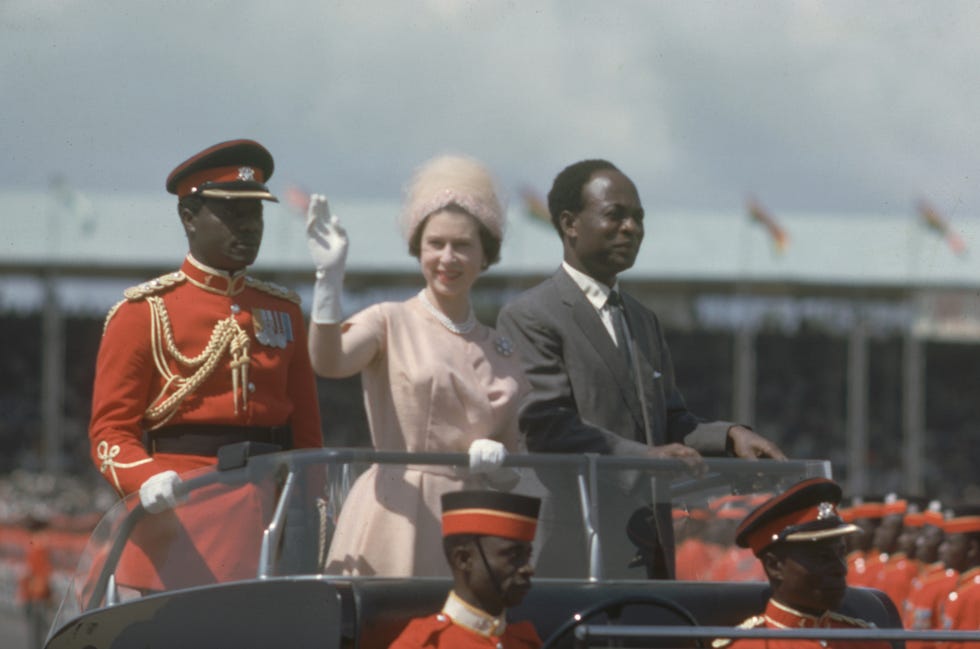

Queen Elizabeth insisted on going to Ghana despite the danger involved
But Elizabeth had always been intent on making the trip to Ghana, and the bombings didn't alter this determination. One reason she was reluctant to reschedule was that she'd already canceled on Nkrumah in 1959 when she became pregnant with Prince Andrew . And though Ghana was part of the Commonwealth, along with other nations that had been part of the British Empire, she knew Nkrumah was getting restless. As head of the Commonwealth, the queen didn't want to insult or embarrass Ghana by postponing the visit, which could push Nkrumah into leaving the group altogether.
In addition, the queen was aware that Nkrumah was getting closer to the Soviet Union, which wanted to expand its foothold in Africa amidst the Cold War. The Ghanaian leader had even traveled to Moscow that October. Soviet attentions toward Nkrumah apparently led to Elizabeth feeling a bit competitive; at one point she declared, "How silly I should look if I was scared to visit Ghana and then [Soviet leader Nikita] Khrushchev went and had a good reception." Elizabeth also told her prime minister, "I am not a film star. I am the head of the Commonwealth — and I am paid to face any risks that may be involved. Nor do I say this lightly. Do not forget that I have three children."

Her visit was a success from start to finish
From the moment Elizabeth arrived in Ghana, along with Prince Philip , she was surrounded by crowds and excitement. Post-independence, the country had embarked on a program of "African socialism" in an attempt to strengthen its economy after years of colonialism. A neo-Marxist Ghanaian paper found Elizabeth to be "the world’s greatest Socialist Monarch in history." It was an unusual description for an enormously wealthy hereditary head of state, but indicated how popular she was.
At a state dinner, Nkrumah toasted Elizabeth by saying, "The wind of change blowing through Africa has become a hurricane. Whatever else is blown into the limbo of history, the personal regard and affection which we have for Your Majesty will remain unaffected." The queen's reply touched on the fact that nations of the Commonwealth could disagree without members needing to leave.
Elizabeth also captured attention by dancing with Nkrumah. Having the queen and a former colonial subject arm-in-arm on the dance floor was a way to demonstrate her acceptance of a new footing between their countries.
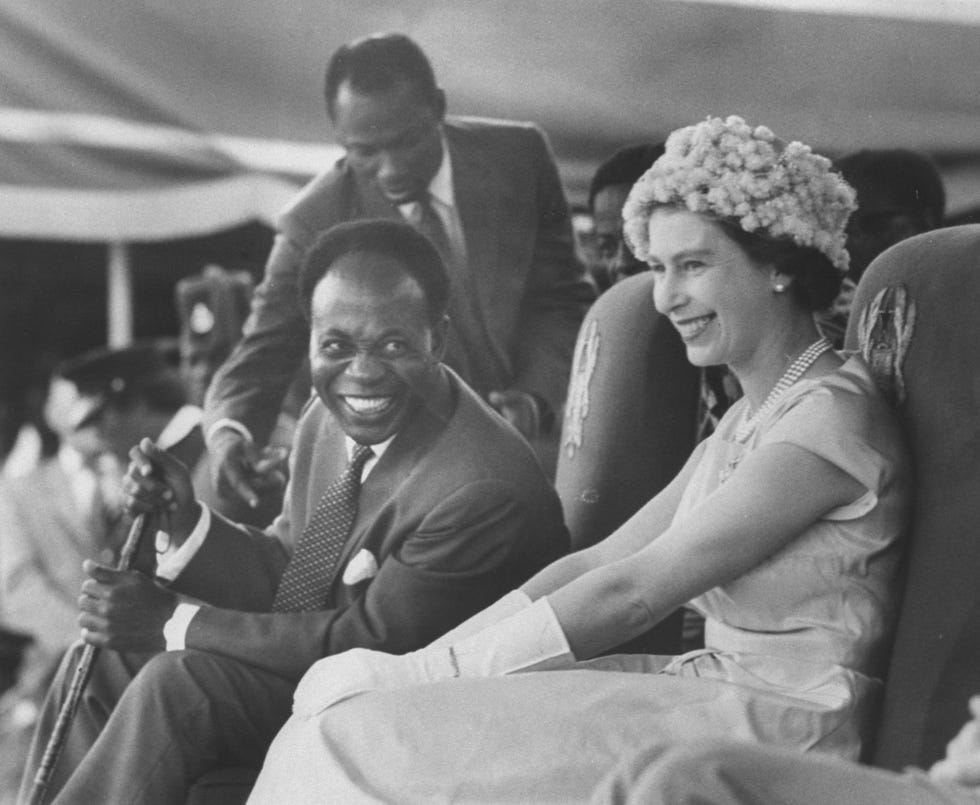
The trip had lasting effects on the Commonwealth
Nkrumah wasn't happy when Elizabeth went to visit the young son of an imprisoned opposition leader during her time in Ghana. But this didn't affect the overall impact of her trip. With the goodwill she'd generated, there was no more talk of Ghana leaving the Commonwealth.
Elizabeth's journey also helped Ghana get highly sought-after funding for the Volta Dam, a hydroelectric project that was a centerpiece of Nkrumah's economic plans. Once she'd returned, Macmillan contacted President John F. Kennedy to say, "I have risked my queen. You must risk your money." Financial backing from the Americans for the project soon came through, which cut off a potential avenue of influence for the Soviets.
Elizabeth's dedication to the Commonwealth meant that this trip would have been a success simply for helping to hold that organization together. However, the visit also demonstrated how, even as a monarch with limited powers, she still had a role to play on the world stage.

Kensington Palace Shares an Update on Kate

Prince William

Where in the World Is Kate Middleton?
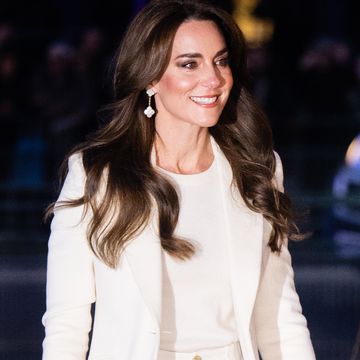
Princess Kate Is Seen for First Time Since Surgery
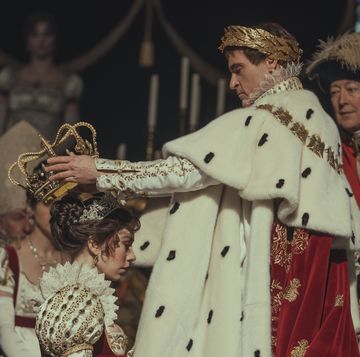
Napoleon and Josephine Had a Stormy Relationship
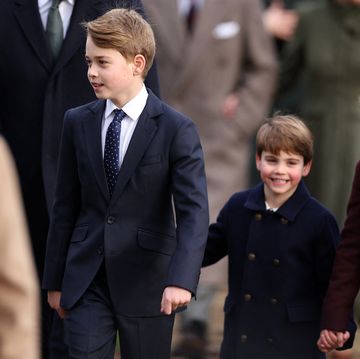
The Most Iconic Photos of Prince George
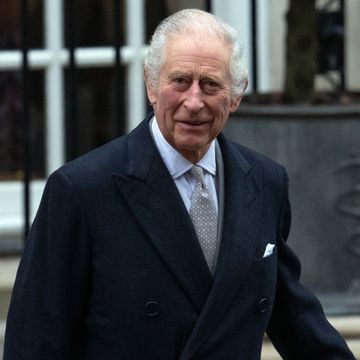
King Charles III
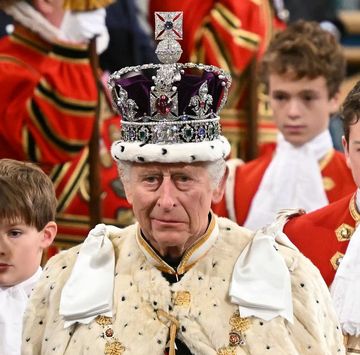
Who’s Who in the British Line of Succession
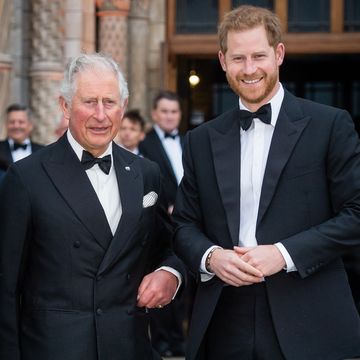
How King Charles Reacted to Prince Harry’s Visit

The True Story of Princess Margaret’s Death

Prince Harry
Global site navigation
- Celebrity biographies
- Messages - Wishes - Quotes
- TV-shows and movies
- Bizarre facts
- Celebrities
- Family and Relationships
- Real Estate
Queen Elizabeth’s Historic Visits To Ghana In Ten Rare Photos
- Queen Elizabeth visited Ghana twice before her demise on Thursday, September 8, 2022
- She first visited Ghana in 1961 under Nkrumah's presidency and again in 1999 under Jerry John Rawlings
- YEN.com.gh presents some of the rare photos that capture her visits to her former colony
New feature: Check out news exactly for YOU ➡️ find “Recommended for you” block and enjoy!
The late Queen Elizabeth II visited several countries worldwide in 1961; however, the most notable of all her visits was the one to Ghana.
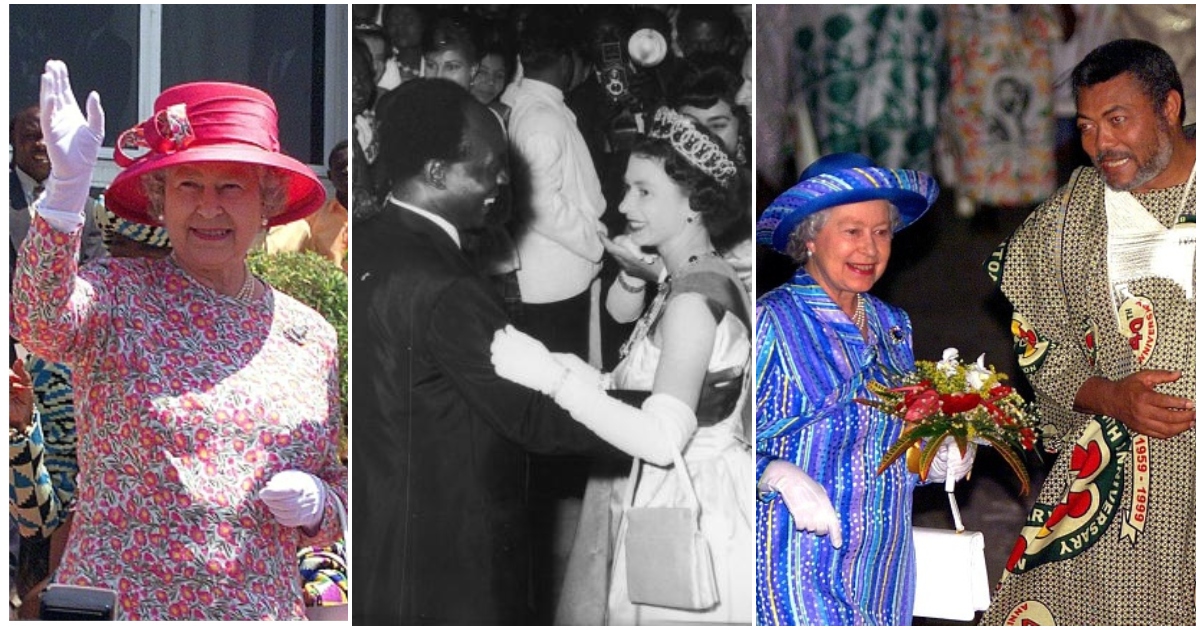
Before she left on the trip, members of the UK Parliament and the public did not want her to go due to rising tensions in Ghana, where Kwame Nkrumah had toppled the colonial government a few years earlier.
The UK Parliament was concerned that her visit could prove too dangerous. But her trip was successful. According to Biography, from the moment Elizabeth arrived in Ghana, along with Prince Philip, she was surrounded by crowds and excitement.
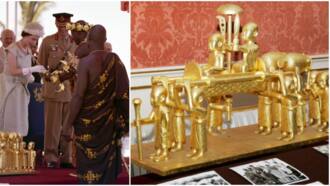
Video captures Fante chiefs giving away massive gold to Queen Elizabeth II in 1961
She would visit Ghana again in 1999 during the 4th Republican administration of late President Jerry John Rawlings .
PAY ATTENTION: Click “See First” under the “Following” tab to see YEN.com.gh News on your News Feed!
YEN.com.gh presents that historic visit to Ghana over six decades ago in ten rare photos.
1. Queen Elizabeth II At Kumasi Sports Stadium
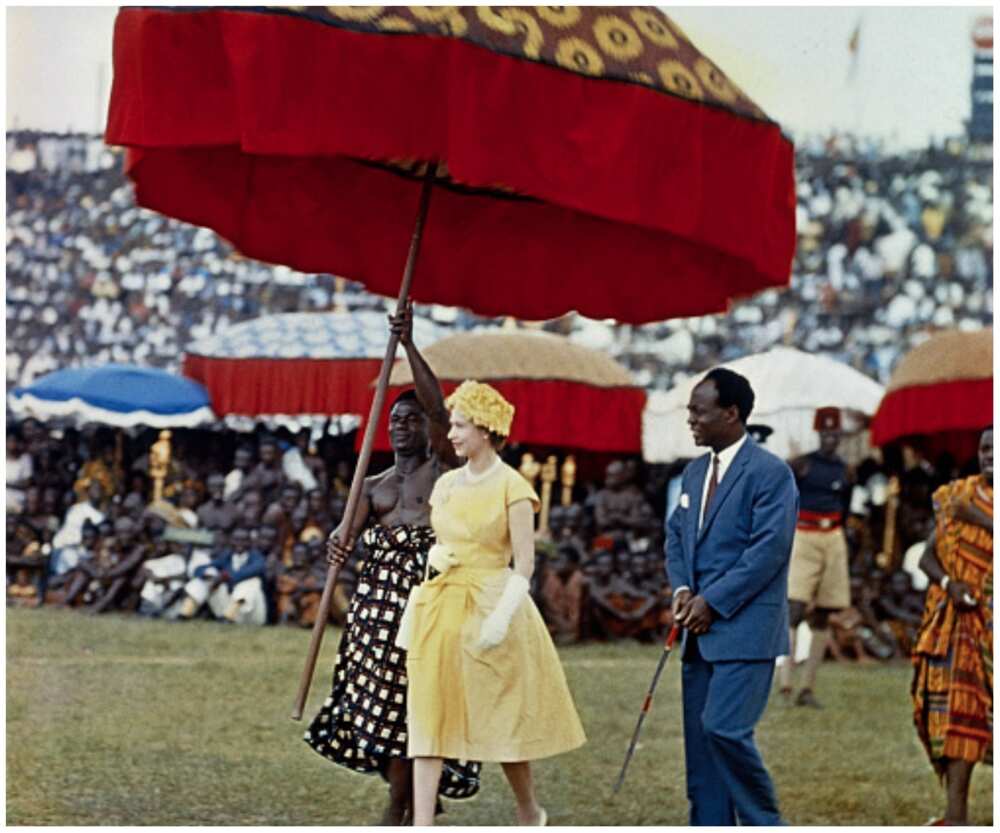
Queen Elizabeth II makes her way underneath a large, gaily colored umbrella, to a dais to watch the Durbar of the Ashanti Chiefs, at Kumasi Sports Stadium, now Baba Yara Stadium.
Here, the late Queen wears a bright yellow outfit, demonstrating that she's always had strong sense for fashion.
Queen Elizabeth II With Kwame Nkrumah

Here Ghana's president in the first Republic, Kwame Nkrumah, and Queen Elizabeth II attend a Diplomatic Corps reception in Accra on November 11, 1961.
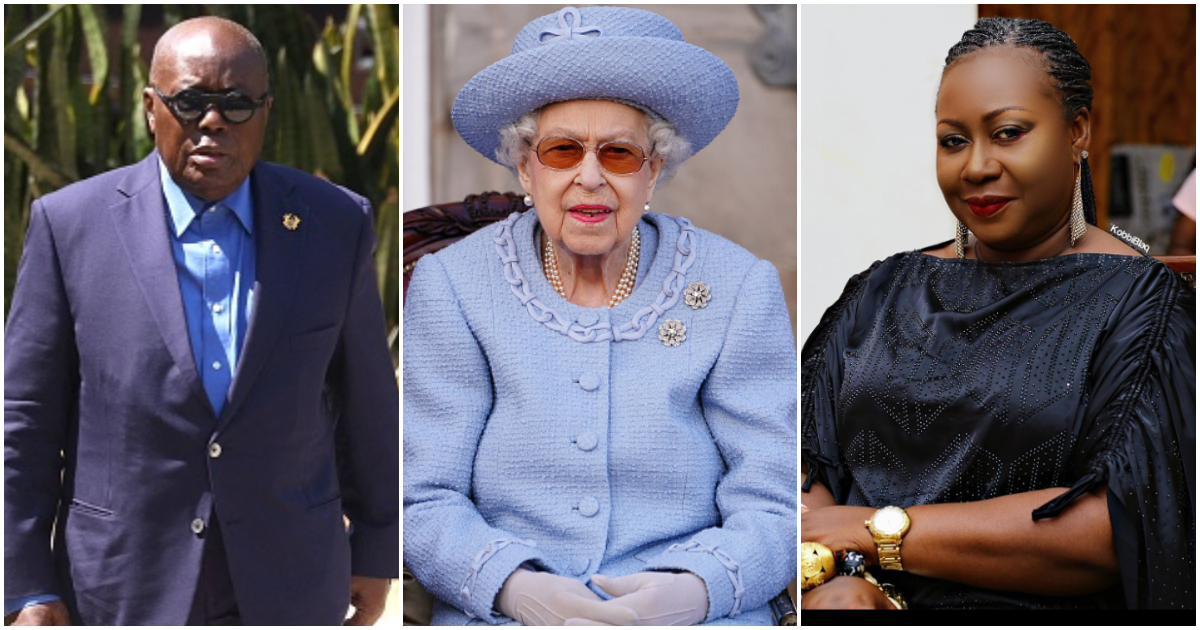
Akufo-Addo, Bawumia, other Ghanaians share touching tributes after Queen Elizabeth II died
The Queen's 1961 visit to Ghana was strategic amid Nkrumah's love-affair with the then Soviet Union.
Queen Elizabeth II Ride With Nkrumah During 1961 Visit
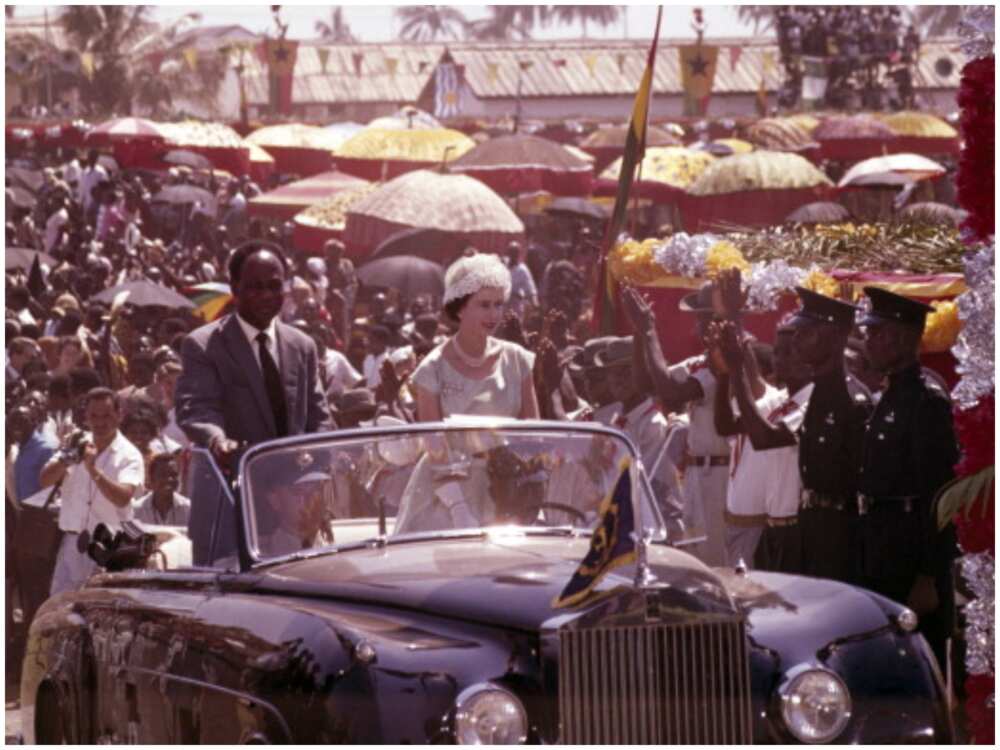
Queen Elizabeth II and President Kwame Nkrumah rode in an open-top limousine through cheering crowds in Accra, during the Royal tour of Ghana in 1961.
The Queen's visit was highly successful, contrary to concerns that it could prove dangerous for her.
Queen Elizabeth II Visits A Ghanaian Market
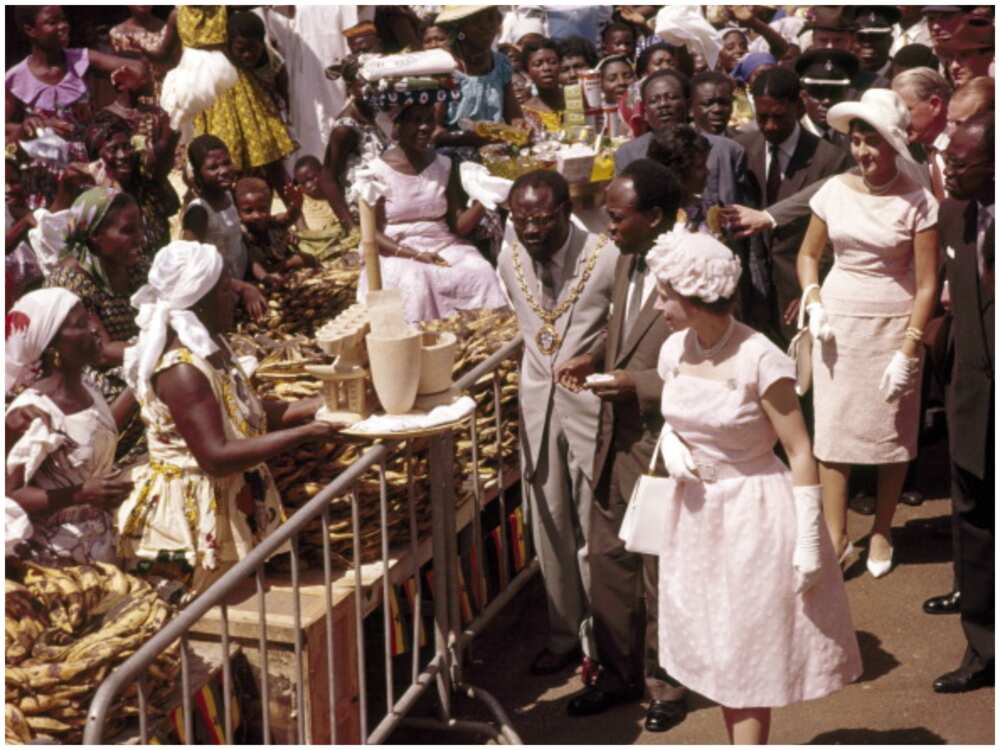
Queen Elizabeth II with President Kwame Nkrumah of Ghana (in dark brown suit) greeting crowds in the marketplace of Accra during the Royal tour of Ghana in 1961.
Her visit to Ghana was seen as a confirmation of Nkrumah's stewardship of the new West African country that had won independence from British rule.
Queen Elizabeth Dances With Nkrumah
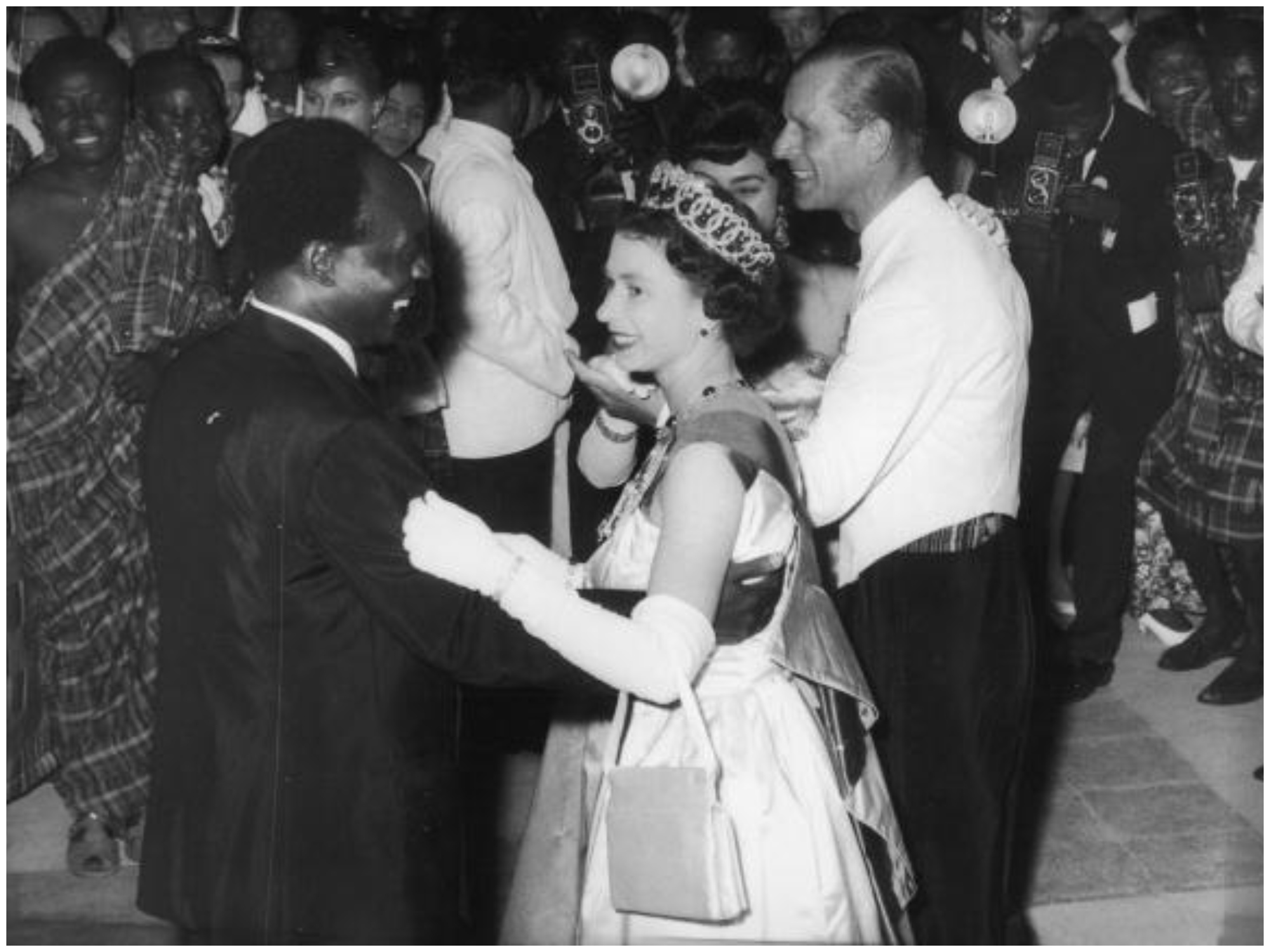
Queen Elizabeth II is seen here dancing with Ghana's first republican president, president Kwame Nkrumah on November 20, 1961, at a farewell ball held at State House, Accra.
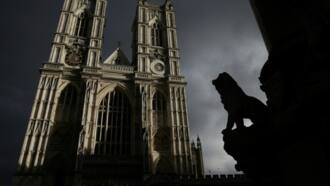
Westminster Abbey's role in Queen Elizabeth II's life
They, and the Duke of Edinburgh, danced to a version of 'High Life' composed specially for the occasion and entitled 'Welcome Your Majesty'.
Queen Elizabeth II Visits Wireless Cluster Junior School

On November 8, 1999, the Queen visited the Wireless Cluster Junior School in Accra during her second visit to Ghana under late President Jerry John Rawlings. The public school was established by the erstwhile British colonial government.
The woman sitting next to her is wearing a dress made of fabric printed with the Queen's portrait and President Rawlings.
Ghana Students Hold Up Portrait Of Queen Elizabeth II
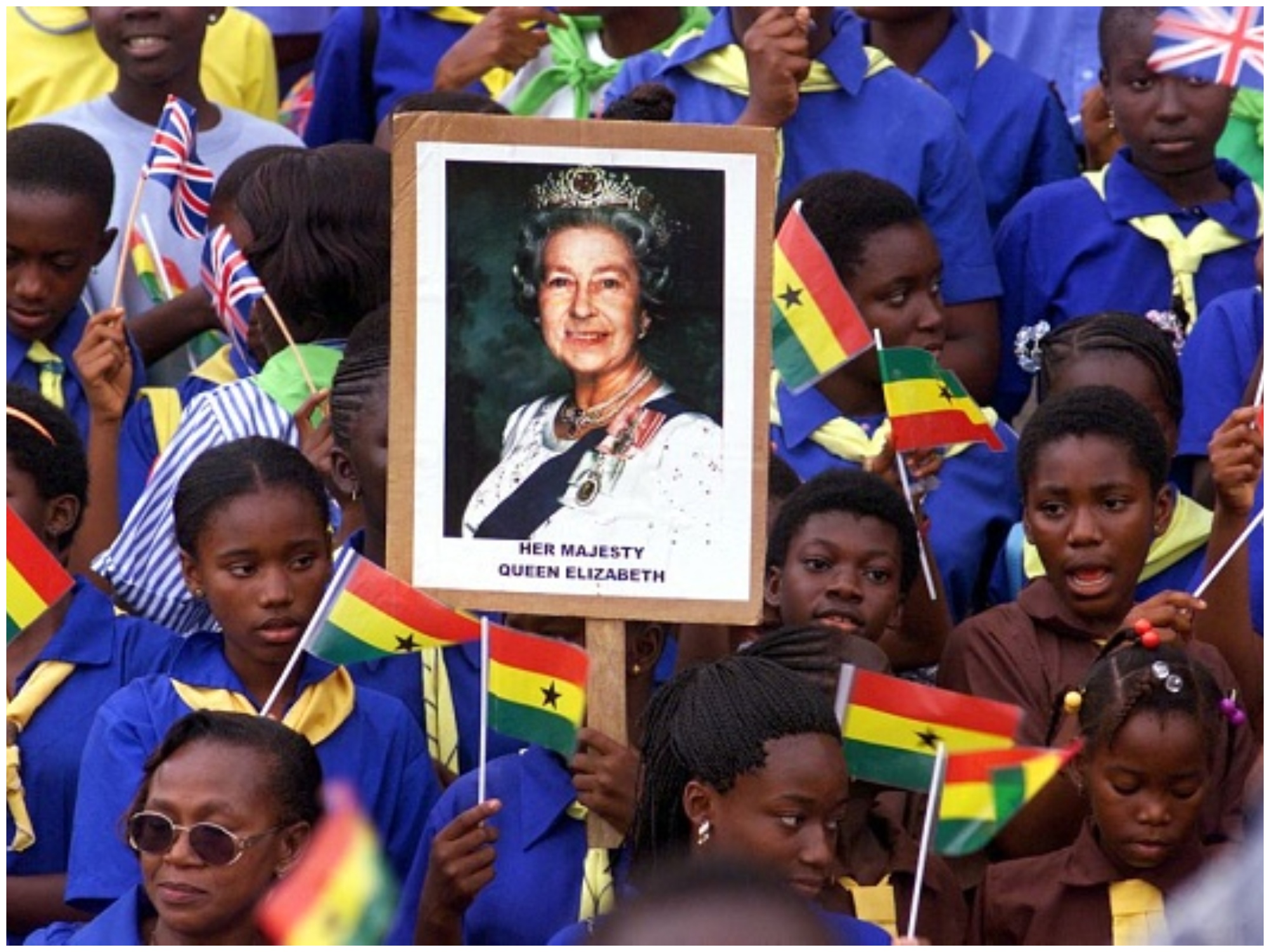
School children hold up a portrait of Queen Elizabeth II upon her arrival in Accra during her two-day visit to Ghana in 1999.
She told Parliament during that visit that the United Kingdom is Ghana’s most significant trading partner and best export customer. She said British investment in Ghana far surpasses that of any other industrialised country.

From Victoria to Elizabeth II: The myth about late Queen's throne in Nigeria
Queen Elizabeth II at a classroom of Wireless Cluster Junior School
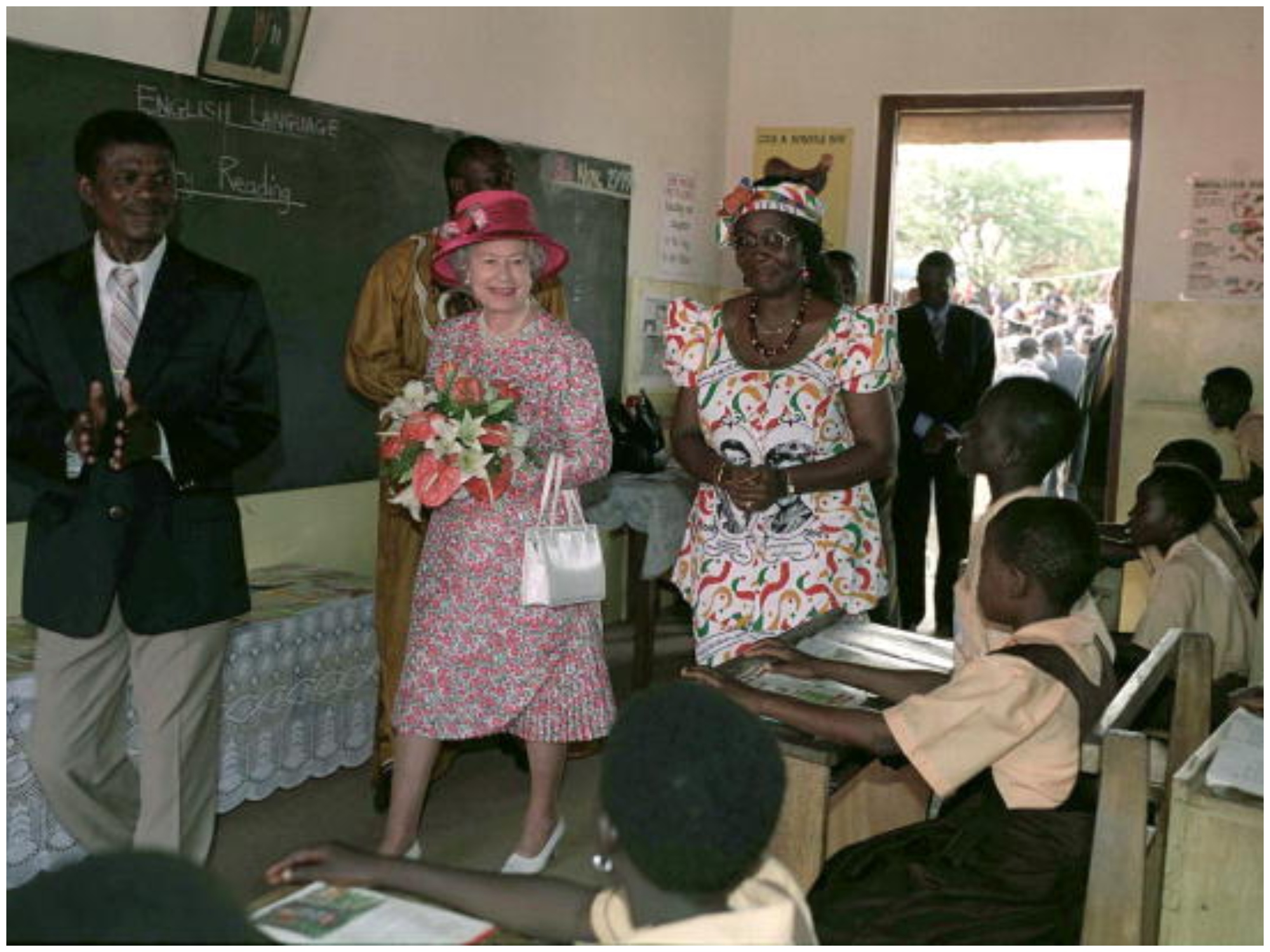
The Queen visited a classroom during her tour of the Wireless Cluster Junior School in Accra during her 1999 visit.
She applauded the work of Ghana’s achievements in Parliament and said she was confident of a successful future for the two countries in the march towards the 21st century.
Queen Elizabeth II Chats With Rawlings During Her 1999 Visit
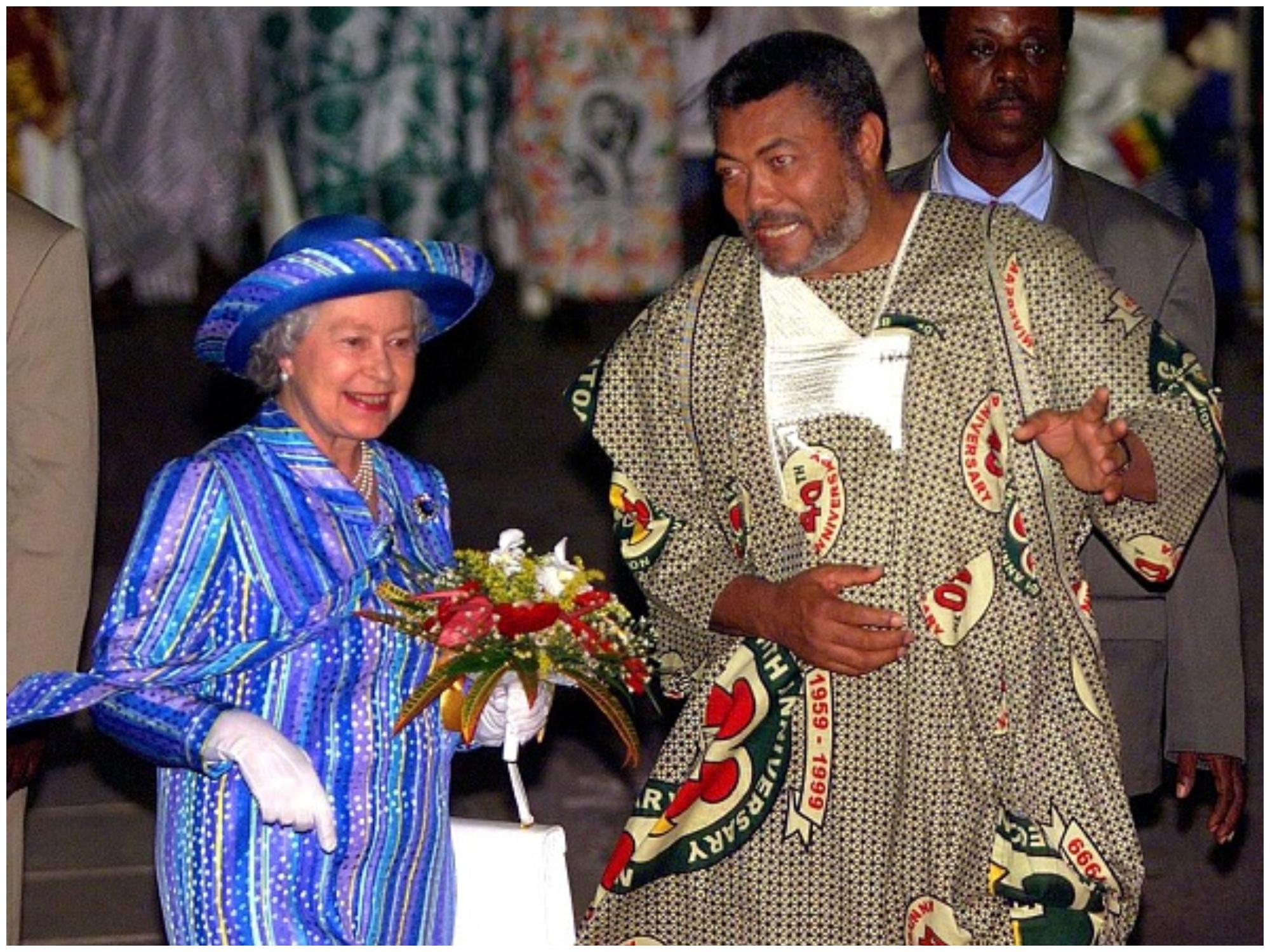
Queen Elizabeth II and Ghanaian President Jerry Rawlings walk together upon the Queen's arrival for a state visit to the former British colony on November 7, 1999.
She commended Rawlings and Parliament for ensuring free media, a truly independent judiciary and a democratically chosen, accountable executive that will provide the conditions under which the equality of opportunity, initiative and a stable society can flourish.
Queen Elizabeth II And Rawlings Wave Shortly After She Addressed Ghana's Parliament

Britain's Queen Elizabeth II and Rawlings wave to the crowd gathered on November 8, 1999 outside the parliament in Accra on the second day of the monarch's two-day visit to Ghana.
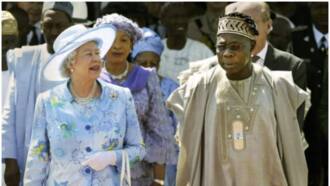
Queen Elizabeth II: How she spent her time in Nigeria, photos drop
She had just concluded a speech to Parliament where she underscored the importance of Ghana to the United Kingdom in terms of trade and business.
Queen Elizabeth II: Five Things That Will Happen Now That Longest Serving British Monarch Has Died
Before her death was announced, the world had been on edge after the Royal Palace announced that Queen Elizabeth II was under medical supervision in Scotland.
Many also said the official statement from Buckingham Palace, which disclosed that doctors were concerned for her health and had "recommended she remain under medical supervision," showed her grave condition. However, Buckingham Palace has announced the Queen died peacefully in her sleep Thursday afternoon at Balmoral, her castle in Scotland.
YEN.com.gh presents the five things that would happen now that Queen Elizabeth II passed on.
New feature: Check out news exactly for YOU ➡️ find "Recommended for you" block and enjoy!
Source: YEN.com.gh
- Skip to main content
- Keyboard shortcuts for audio player
Goats and Soda
- Infectious Disease
- Development
- Women & Girls
- Coronavirus FAQ
'The Crown' Says One Dance Changed History. The Truth Isn't So Simple
Tim McDonnell

Queen Elizabeth II dances with Ghanaian president Kwame Nkrumah at a ball in Accra, Ghana, in 1961. Central Press/Getty Images hide caption
Queen Elizabeth II dances with Ghanaian president Kwame Nkrumah at a ball in Accra, Ghana, in 1961.
It was a highlight of the latest season of the Netflix series The Crown , which chronicles the early years of Queen Elizabeth II's reign: The year is 1961, the Cold War is heating up and the queen (played by Claire Foy), feeling self-conscious after learning that First Lady Jackie Kennedy (Jodi Balfour) called her "incurious" at a dinner party, decides to take a more proactive role in dealing with Ghana, a former colony whose new leader, Kwame Nkrumah (Danny Sapani), appears to be getting too cozy with the Soviets.

Season 2 Of 'The Crown' Exposes The Royal Family's Fitful Evolution
Her solution: A dance with Nkrumah at a ball in the capital, Accra. The foxtrot, specifically, to the extreme, hilarious consternation of Prime Minister Harold Macmillan (Anton Lesser).
It's a high-stakes political gamble that could decide the balance of Soviet power in Africa, which in the early 1960s was fast emerging as a Cold War battleground. To everyone's relief, the dance is a success. The implication is that, in exchange for his photo op dancing with the queen, Nkrumah will "come back to the fold" and squash Soviet hopes for Africa. Later, JFK (Michael Hall) crows to Jackie that her jab at the queen precipitated a major foreign policy victory for the U.S. and U.K. It's the foxtrot that changes the course of history.
"Well, that's nice," says Nat Nuno-Amarteifio , an architect and amateur historian who served as mayor of Accra from 1994-98 and remembers the queen's supposedly fateful visit from when he was a teenage student. "It's a lot of bulls**t."
'The Crown' Creator Peter Morgan

- LISTEN & FOLLOW
- Apple Podcasts
- Google Podcasts
- Amazon Music
Your support helps make our show possible and unlocks access to our sponsor-free feed.
It turns out The Crown got a lot wrong about that dance, according to Nuno-Amarteifio and other Ghanaian history experts.
There's no dispute that the Ghana visit happened, or that Nkrumah and the queen shared a dance, as shown in the photo above. But the dance wasn't exactly a pivotal moment for Nkrumah's political philosophy, which continued to adhere to socialism in subsequent years, even earning him the Lenin Peace Prize the year after the queen's visit.
"I'm surprised that the dance has attained this retroactive reputation," Nuno-Amarteifio says. "Nobody talked about it then."
At the time, Nkrumah was likely Africa's most influential leader. As a young man in the mid-1930s, he had scraped together enough cash from his farming family in what was then the British colony of Gold Coast to travel to the U.S. for an education. He worked his way through philosophy and theology degrees at Lincoln College and the University of Pennsylvania, followed by two years in London forming alliances with other anti-colonial organizers who were poised to dislodge Britain, France and other colonial powers from their seats in Africa. In 1947, when a pro-independence party began to gather momentum in Accra, its members recruited Nkrumah as their leader. He returned to Gold Coast, but soon found himself imprisoned in a converted British beach fort after a strike he helped organize turned violent. Still, at the next election in 1951, he ran for office from his cell and won a seat in Parliament. As his party's leader, he was installed as prime minister, and the British had no choice but to release him.
Over the next several years he helped coax the country toward independence, under the watchful eye of a British governor. During that time, he nurtured a cult of personality, promoted by newspapers as a kind of towering superhero who would soon vanquish the imperialists who had occupied the country for nearly a century. Sure enough, in 1957 Nkrumah succeeded in passing legislation granting Ghana full self-government, making it the first colony in sub-Saharan Africa after South Africa to gain independence. The independence celebration in Accra was attended by political leaders from across the globe, including Vice President Richard Nixon (according to historian Martin Meredith's The Fate of Africa , Nixon infamously asked a black guest at the party how it felt to be free, to which the man reportedly replied, "I wouldn't know, sir. I'm from Alabama.").
That party featured another royal dance, a prelude to Nkrumah's encounter with the queen several years later. Meredith recounts that Nkrumah was warned he would need to dance with the Duchess of Kent, who would be there to represent the Crown. But Nkrumah was ill-trained in Western dance and only felt comfortable with highlife , a West African pop style. It fell to another guest, Louis Armstrong's wife, Lucille, to teach him the foxtrot.
During the country's early years, Nkrumah committed to the socialist sentiments he had first picked up in the U.S. and London, with the belief that a centrally planned economy and state control of cocoa and other valuable industries — what Nkrumah and others took to calling "African socialism" — were essential for the new country to shake the chains of colonialism. This was very concerning to President Kennedy, who in 1962 called Africa "the greatest open field of maneuver in the worldwide competition between the communist bloc and the non-communist." But it was not unique; several other newly-independent African nations, including Kenya, Mali and Tanzania, took guidance from the USSR, which, according to Meredith, "seemed to show that socialism produced rapid modernization."
In The Crown , that embrace is dramatized by a scene in which a portrait of the queen is taken down in the Ghanaian parliament building and replaced with one of Lenin. But although Nkrumah did tour Eastern Europe, his attachment to the USSR was never so extreme, Nuno-Amarteifio recalls.
"Our roots with Russian communism were more intellectual than anything else," he says. "There was nothing visceral about it. Lenin wasn't a personality that we associated with liberty or freedom. If anything, 99 percent of Ghanaians wouldn't have known who Lenin was."
John Parker , an historian at the University of London's School of Oriental and African Studies, agreed that Nkrumah's ties to socialism were mostly ideological and detached from specific foreign policy agreements with the USSR. Still, Nkrumah was seen as a wild card by the U.S. and U.K., and the queen's visit was part of a broader strategy (not an individual impulse, as represented in the show) to corral him and other rogue leaders.
"The British government was certainly concerned to limit Soviet influence in ex-colonies," Parker says. "Overseas tours by the queen were designed broadly to strengthen Commonwealth links."
Meanwhile, African socialism wasn't exactly working the way Ghanaians hoped it would. By the time of the queen's visit in 1961, the economy was crumbling, bribes were routinely collected by government officials at every level of the system (including by Nkrumah himself, who, according to Meredith, even set up a special state-run company to facilitate bribe collection from foreign businessmen) and political opponents were frequently jailed.
"There was a lot of unhappiness, and Nkrumah's position was already delicate," Nuno-Amarteifio says. "If the queen was brave to come to Ghana, he was also brave to welcome her, because it exposed him to tremendous embarrassment should anything happen. The whole world would be watching."
Fortunately, the event seems to have gone off smoothly. As for the dance itself, Nuno-Amarteifio says it barely registered with him and his friends at the time. If anything, he says, The Crown 's depiction of the ecstatic Ghanaian press and bewildered British bureaucrats, shocked that the queen would deign to dance with an African, comes across as paternalistic.
"It was a young white woman dancing with an African," he says. "What do you expect me to do, applaud?"
Did the visit accomplish anything? The big hydroelectric dam referenced in the episode was eventually built, not by the USSR but by an Italian company with financing from the U.S. and U.K. But "Ghana did not 'sever links' with the USSR," Parker says. "To suggest that [the dance] — or the royal tour as a whole — "tipped the balance" of Soviet power in West Africa is untrue."
Nkrumah would remain a proponent of socialism the rest of his life. In 1966, while on a trip to North Korea and China, he was deposed in a military coup that was likely orchestrated by the CIA.
In other words, the episode not only makes much ado out of a forgettable moment but uses that representation to manufacture a victory for the U.S. and U.K. that never really happened. Or, as Nuno-Amarteifio puts it: "I still don't know why that stupid dance is so important."
Tim McDonnell is a journalist covering the environment, conflict and related issues in sub-Saharan Africa. Follow him on Twitter and Instagram .
- Kwame Nkrumah
- Queen Elizabeth II
- soviet union
Watch: Queen Elizabeth II's 1961 visit to Ghana
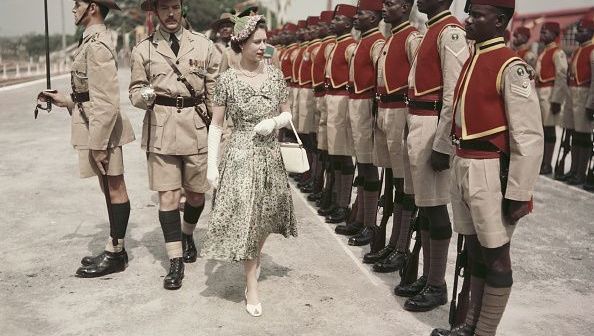
Queen Elizabeth II inspects men of the newly-renamed Queen's Own Nigeria Regiment, Royal West African Frontier Force, at Kaduna Airport, Nigeria, during her Commonwealth Tour, 2nd February 1956. (Photo by Fox Photos/Hulton Archive/Getty Images) Image: Getty Images
The year was 1961, and Queen Elizabeth II was establishing a reputation for herself as a real jet setter. Watch this British Pathé footage of the Queen in Ghana, West Africa.
In 1961, Queen Elizabeth visited several countries around the world, but perhaps what was most notable was her very first trip to Ghana, a country in West Africa. The young Queen showed during this trip that while the Royal's family's powers were limited the monarchy could still have an impact.
Ghana is a former British colony that gained its independence in 1957. British members of Parliament and the public did not want the Queen to take the trip due to rising tensions in a country where President Kwame Nkrumah was well on his way to becoming a dictator.
Five days before Elizabeth's trip was to begin, bombs went off in the capital city of Accra. A statue of Nkrumah was hit, which showed the president was a target.
The Queen was not deterred. One reason she was reluctant to reschedule was that he had previously canceled in 1959 when she was pregnant with Prince Andrew. As the head of the Commonwealth, the Queen did not want to insult Ghana by postponing the visit.
The other reason being that the Queen was aware Nkrumah was getting closer to the Soviet Union, which wanted to expand its foothold in Africa amidst the Cold War. The Ghanaian leader had even traveled to Moscow that October.
At one point Queen Elizabeth declared "How silly I should look if I was scared to visit Ghana and then [Soviet leader Nikita] Khrushchev went and had a good reception."
She also told the Prime Minister "I am not a film star. I am the head of the Commonwealth — and I am paid to face any risks that may be involved. Nor do I say this lightly. Do not forget that I have three children."
However, the Queen's trip went well. HRH Elizabeth was met by President Kwame Nkrumah in Accra, the nation's capital. Huge crowds gathered to greet Queen Elizabeth as she met with dignitaries and several government ministers.
Have a look at the footage below, courtesy of British Pathe
- WATCH: Queen Elizabeth Attends The Opera
- Princess Anne's christening
* Originally published in March 2020. Updated in 2022.
BHT newsletter
You may also like.
- Most Recent

Queen Victoria's coffin and the ...
A stern Queen, overcome by grief, who oversaw 63 years as the Monar...

The Irish Lord who captured Quee...
Queen Elizabeth and Patrick Plunket enjoyed a special relationship....
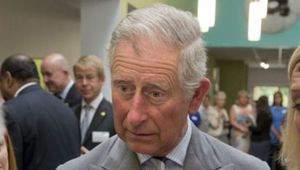
The strict rules King Charles ma...
King Charles is quite particular with his tea...
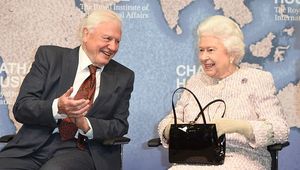
Queen Elizabeth and David Attenb...
Queen Elizabeth II, the longest-reigning monarch in British history...
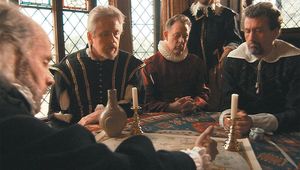
What was life like in Britain in...
What was life really like for people in Britain during the 1600s, t...

When Prince Philip was a pillar ...
A touching moment between the Duke of Edinburgh, Prince Philip, and...
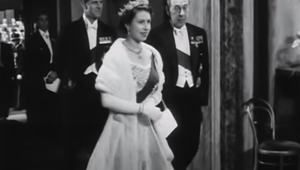
WATCH: Queen Elizabeth Attends T...
Have you seen this incredible footage of Queen Elizabeth at the opera?

The day Buckingham Palace was bo...
Friday 13th, a day that sends shivers down everyone's spine, and is...
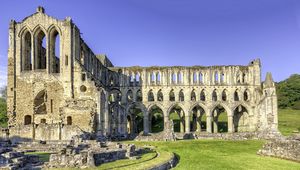
Yorkshire’s medieval Cistercian ...
Did you know there are four Cistercian abbeys in Yorkshire, includi...
Accessibility Links

Queen dancing in Ghana: The story behind her iconic visit to save the Commonwealth
Despite warnings of violence, elizabeth ii was determined to go to ghana and keep the african republic in the fold.

T he Queen danced gaily with Ghana’s president in 1961, seemingly unaware that their dance was a symbolic moment in the history of the Commonwealth.
Elizabeth II is pictured beaming on the dancefloor with President Nkrumah, whom the West had feared was getting too close to the Soviet Union, at a farewell ball in Accra. Despite bombings in the capital, the Queen had insisted on this tour to make sure the unstable African republic did not leave the Commonwealth.
In The Queen: Her Commonwealth Story , to be broadcast tonight, Ghanaian historian Nat Nunoo Amarteifio said that the Queen was gallant to visit because the Commonwealth could have easily become an almost white-only club.
Remembering the dance, he said: “A man could not have done it
Queen Elizabeth II and Africa: From an iconic dance in Ghana to friendship with Mandela
Elizabeth II maintained special ties with Britain’s former colonies and the members of the Commonwealth states in Africa. From the beginning of her reign in Kenya to her memorable meetings with Kwame Nkrumah and Nelson Mandela, the Queen had a long-standing relationship with the African continent.
Issued on: 10/09/2022 - 17:54 Modified: 10/09/2022 - 17:56
Elizabeth II visited Africa 21 times during her 70-year reign. According to the British Royal Family’s website, the Queen had visited nearly every country in the Commonwealth, yet some overseas visits were more impactful than others. Her first trip was particularly important.
On February 6, 1952, Princess Elizabeth and her husband Philip , already parents of Charles, born in 1948, and Anne, born in 1950, found themselves in the heart of the Aberdare mountain range, in central Kenya. They planned to spend a night at Treetops, a game-viewing lodge located 7,000 kilometres from England.
In the morning, the news came: George VI, Britain’s monarch for the last 15 years, had just died at the age of 56. With his death, the crown passed down to his eldest daughter, then in a distant country that was not yet a member of the Commonwealth – Kenya would not join until 1963. Elizabeth II would not learn of the death of her father until after her departure from Treetops, but it was in that hotel that her reign began.
"I am quite certain that this is one of the most wonderful experiences the Queen or the Duke of Edinburgh have ever had," read a letter dated February 8, 1952, written by an aide to the royal couple, responsible for thanking the owners of the hotel. Treetops burned down in 1954 and a new, much larger establishment has been built since then.
Elizabeth II briefly returned to Kenya in March 1972. In November 1983, she and her husband stayed in the country for four days and returned to Treetops, the lodge where she found herself when she became queen. This time she and her husband were more formally dressed. The Queen set foot in Kenya for the last time in October 1991.
On Friday, September 9, 2022, Uhuru Kenyatta, the outgoing president of Kenya and son of Jomo Kenyatta, the former president who welcomed the Queen in 1972, paid tribute to Elizabeth II in a message of condolence. "Her Majesty Queen Elizabeth II was a towering icon of selfless service to humanity and a key figurehead of not only the United Kingdom and the Commonwealth of Nations, where Kenya is a distinguished member, but the entire world," he wrote.
I have received news of the death of Queen Elizabeth II and I send condolences to the people of the United Kingdom. The queen’s leadership of the Commonwealth for the past seven decades is admirable. pic.twitter.com/PT3Fv6ws7u — William Samoei Ruto, PhD (@WilliamsRuto) September 8, 2022
Kenya's new President-elect William Ruto also paid tribute to the Queen on Thursday, hailing her "admirable" leadership of the Commonwealth. "May her memories continue to inspire us. We join the Commonwealth in mourning and offer our condolences to the Royal Family and to the United Kingdom," he said, after describing the evolution of the Commonwealth as a testament to "the historic legacy" of the Queen.
In Ghana, an iconic dance with Kwame Nkrumah
Of all her tours in Africa, the one at the end of 1961 was among the most crucial, says Meriem Amellal Lalmas, a journalist at FRANCE 24. The Queen decided to travel to Ghana from November 9 to 20, despite opposition from the British press and politicians, who were wary of a visit at a time when Kwame Nkrumah, then the Ghanaian president, was drifting towards authoritarianism. Winston Churchill himself, a mentor to Elizabeth II, even called the prime minister at the time, Harold Macmillan, and asked him to convince the Queen not to visit the country that had declared its independence in 1957.
The sovereign refused to cancel the visit. She knew her visit was eagerly awaited. The upcoming birth of her third child, Andrew, had already forced her to cancel the trip in 1959 and Nkrumah had taken it badly. To ease tensions, the royal family had invited him to Balmoral, where the head of state had spent a few days with the Queen. Later, Prince Philip travelled to Ghana and promised an upcoming visit from his wife.
It was a high-stakes visit. Nkrumah, a Marxist, was cosying up to the Soviet bloc at the time and threatened to slam the door on the Commonwealth. Upon her arrival, the British Queen was very well received by the Ghanaian authorities. However, it was during a ball organised in her honour that she managed to turn the tide of public opinion: in front of the world’s cameras, she danced with the president of Ghana.
"This image seems mundane today but in this context, it was extremely avant-garde. It was a white woman dancing with a black man, it was the ruler of an empire dancing with a subject, as he was then considered, even if he is also the father of pan-Africanism and Ghanaian independence ", explains Meriem Amellal Lalmas.
The Queen's visit did not prevent Nkrumah from getting closer to the Soviet bloc, but it did stop Ghana breaking away from the Commonwealth. The Queen reassured the president and helped him obtain funding. Nkrumah later declared: “The winds of change blowing through Africa have become a hurricane. Whatever else is blown into the limbo of history, the personal regard and affection which we have for Your Majesty will remain unaffected.”
Last Thursday, Ghana's current president, Nana Akufo-Addo, was the first head of state to react to Elizabeth II’s death. On Twitter, he wrote: "As Head of the Commonwealth of Nations, she superintended over the dramatic transformation of the Union, and steered it to pay greater attention to our shared values and better governance. She was the rock that kept the organisation sturdy and true to its positive beliefs. We shall miss her inspiring presence, her calm, her steadiness, and, above all, her great love and belief in the higher purpose of the Commonwealth of Nations, and in its capacity to be a force for good in our world."
Nelson Mandela, the friend from South Africa
A member of the Commonwealth since its foundation, South Africa was a special country for Elizabeth II. She toured the country on her first trip to the African continent, in 1947. It was there, on her 21 st birthday, on April 21, 1947, that the future queen declared in a speech that she would dedicate her life to the service of the Commonwealth.
Faithful to the tradition of neutrality, the Queen did not speak out against apartheid until the end of the racist regime. In his book "Great Britain and the World" (ed. Armand Colin), the historian Philippe Chassaigne explains that Elizabeth II did not want to go to South Africa again "because it would have meant supporting the policy of apartheid”. She was only able to provide discreet support to Brian Mulroney, the Canadian prime minister who was campaigning for economic sanctions against South Africa in the beginning of the 1980s. Margaret Thatcher, then British prime minister, was on the opposite side.
The complicated relationship between Elizabeth II and Margaret Thatcher was also embodied in the United Kingdom's approach to Nelson Mandela : while the "Iron Lady" considered the African National Congress (ANC), the party of Madiba, a "terrorist organisation", the Queen reached out to the future South African leader who had spent 27 years in prison. Shortly after his release in 1990, she welcomed Nelson Mandela to the United Kingdom. When Mandela won the presidential election five years later, the queen traveled to South Africa to meet with him.
Previously, in 1991, Elizabeth II broke with protocol by inviting Mandela to the Commonwealth Summit in Harare, Zimbabwe, even though he did not have the required rank to attend the Queen's banquet. The Queen, aware of the symbolic significance of this invitation, had already lost some of her reserve when she said that she was content to see the end of apartheid.
Reacting to the Queen's death, the Mandela Foundation published a press release on Friday evoking the very friendly relationship between these two major figures of the 20th century: "They also talked on the phone frequently, using their first names with each other as a sign of mutual respect as well as affection [. . .] In the years following his release, Nelson Mandela cultivated a close bond with the queen”, whom he had nicknamed “Motlalepula” (“come with the rain”), after her 1995 visit which was marked by torrential rains.
Complicated relations with Robert Mugabe's Zimbabwe
The only country in Africa to have left the Commonwealth, Zimbabwe had been a complicated and cumbersome partner for Queen Elizabeth II. In 2002, the organisation decided to suspend the country from its Council, as a way of sanctioning of the presidential election organised that year. Elected in 1990 and re-elected in 1996, President Robert Mugabe won against Morgan Tsvangirai with 56.20% of the vote in an election marked by violence and fraud.
A year later, Zimbabwe decided to slam the door of the Commonwealth, outraged to learn that the organisation wanted to maintain its suspension. Robert Mugabe took the opportunity to describe the Commonwealth as an organisation run by "racist whites". In 2008, he was newly re-elected, with 90.22% of the vote, in a race that was once again denounced by many democracies in the world.
In June 2008, the crack between London and Robert Mugabe grew wider: David Miliband, the minister of foreign affairs, proposed to strip the Zimbabwean president of his honorary knighthood, which had been awarded to him in 1994, with the approval of Elizabeth II. "This decision was taken as a sign of revulsion at the human rights abuses and abject disregard for the democratic process in Zimbabwe under the rule of President Mugabe," the British Foreign Ministry wrote in a statement.
This article is a translation of the original in French.
Daily newsletter Receive essential international news every morning
Take international news everywhere with you! Download the France 24 app
- Queen Elizabeth II
- Commonwealth
- Nelson Mandela
- British Royal Family
The content you requested does not exist or is not available anymore.
Edward A. Ulzen Memorial Foundation
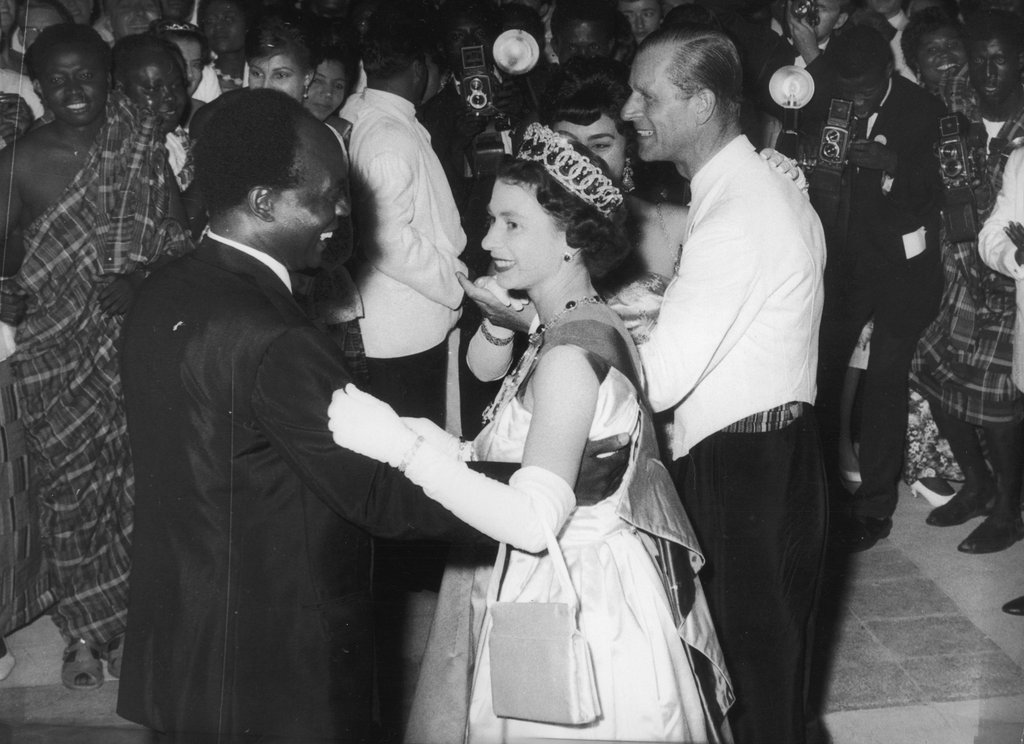
November 10, 1961: HM Queen Elizabeth II begins a Royal Tour of Ghana
“I am not a film star,” said the Queen of England to Prime Minister Harold Macmillan. “I am the head of the Commonwealth and I am paid to face any risks that may be involved. Nor do I say this lightly. Do not forget that I have three children.” Thus Queen Elizabeth II agreed with Macmillan the previous week when he conveyed to her his Cabinet’s advice that she should carry out her royal visit to Ghana, despite a spate of bombing incidents in Accra protesting the rule of Kwame Nkrumah.
Undoubtedly the world’s most powerful woman at the time, the young Queen Elizabeth took a trip to Ghana in 1961; four years after the sub-Saharan nation had gained independence from her country. This visit witnessed parades and festivals in her honor with kings, queen-mothers, princes and a host of other nobles present to pay homage to the ruler of the commonwealth.
The visit was preceded by lengthy deliberations regarding risks because of a bombing campaign in Ghana by opposition operatives. Prime Minister Harold Macmillan's statement on November 8, was as follows: “… I thought it right that the Commonwealth Secretary should pay a second visit to Ghana. This has been done. He returned to this country this morning. My colleagues and I have had from him a full appreciation of the position based on his personal inquiries on the spot. “Of course, no Royal tour is without risk. Her Majesty knows this as well as any Member of the House. But she has never been deterred in undertaking previous tours because of the personal risk to herself which is inevitable, especially when great crowds are assembled. Happily, she has come triumphantly through these trials with the enhanced affection and admiration of all. “After considering carefully and anxiously all the information before us, collected and assessed by those best qualified to do so, the Government have reached the conclusion that the degree of risk attaching to this tour is no greater than those which have been present in many of Her Majesty's previous journeys. “There are those who will ask how this conclusion can be reconciled with the explosions which have taken place in Accra during the last few days. That was one of the questions which was in the forefront of my mind when I decided it would be right for the Commonwealth Secretary to visit Ghana again. “He has given us his first-hand assessment of the significance of these incidents. While he was in Accra he took the opportunity to tour the Royal route in company with President Nkrumah, and he saw for himself the unmistakable friendliness of the crowd. “We have also had the expert advice, based on a thorough investigation on the spot, of those in this country best qualified to do this sort of work. We have had the ready co-operation of the Ghanaian authorities. “I can assure the House that, on the information and advice available to them, the Government have formed the view that the explosions did not indicate any intention by those concerned to perpetrate acts of violence during the Queen's visit which would endanger Her Majesty's safety. We have, therefore, no reason to fear that this journey will involve any additional risk to Her Majesty's safety. “On the other hand, the cancellation of this visit, so long promised and awaited by the people of Ghana, would impair the invaluable contribution made by Her Majesty's Journeys to the strengthening of the ties which bind together the peoples of the Commonwealth. The Government have therefore advised the Queen that she should proceed with her visit to Ghana. “We of course at once informed the other Commonwealth countries, with whom we have been in touch throughout. May 1, therefore, on behalf of the whole House, send Her Majesty our warmest good wishes for the success of her West African tour and a safe Return" Replying to Mr. Turton (C.), Mr. Macmillan said that the Government had been in touch with all the Commonwealth Prime Ministers and had sent them personal messages; he thought he could say that no Commonwealth Government had expressed a contrary view. Mr. Gaitskell and other Members joined with the Prime Minister in wishing the Queen a “very happy and successful tour.” The Queen and the Duke of Edinburgh accordingly left London Airport in the morning of Nov. 9 on their 3,600-mile non-stop flight to Accra.
https://pro.magnumphotos.com/Catalogue/Ian-Berry/1961/GHANA-Queen-Elizabeth-II-visit-1961-NN142904.html
The Queen of travel
Queen Elizabeth II 1926 - 2022
Queen Elizabeth II leaves Fiji during a royal tour in February 1977. Serge Lemoine/Getty Images
The Queen of travel Journeys of a lifetime
By Francesca Street and Mark Oliver, CNN September 13, 2022
S he was traveling the moment she ascended to the throne, and for much of the next seven decades, Queen Elizabeth II criss-crossed the world. Newly married and still just a princess, Britain’s future monarch was in Kenya with husband Prince Philip in February 1952 when she learned of her father’s death and her new regal status.
During her reign she would visit more than 120 countries, witnessing first-hand the revolutions in global travel that shrank the world as her own influence over it diminished.
The Queen lived through the advent of the Jet Age, flew supersonic on the Concorde, saw regimes change, countries form and dissolve, the end of the British Empire and the rise of globalization.
Here are some of the most memorable travel moments from her 70 years as monarch.
November 24-25, 1953
Less than six months after she was crowned at Westminster Abbey in London, Queen Elizabeth set off on her travels again. Her debut official state trip was an epic six-month tour of the Commonwealth -- the alliance of nations which were once British colonies. Traveling by air, sea and land she visited several countries, accompanied by her husband, Prince Philip, the Duke of Edinburgh. First stop was the North Atlantic island of Bermuda, a British territory she would visit a further four times during her reign. The trip would go on to include stops in Jamaica, Tonga, New Zealand, Australia, Cocos Islands, Ceylon (now Sri Lanka), Aden (now part of Yemen), Uganda, Malta and Gibraltar.
December 19-20, 1953
At Queen Elizabeth’s coronation in June 1953, Queen Salote Tupou III of the Polynesian kingdom of Tonga won over the British public when she sat, rain-soaked, in her open carriage. They also took an interest when Elizabeth returned the visit later in the year. The two queens enjoyed an open-air feast, watched Tongan dancers and admired a tortoise that legend said was presented by explorer Captain James Cook to the King of Tonga in 1777.
December 23, 1953 – January 30, 1954
New zealand.
The Queen voyaged to New Zealand during the Antipodean summer of 1953-4. Over the course of the trip, it’s estimated that three out of every four New Zealanders got a glimpse of her. In preparation for the Queen’s visit, some New Zealand sheep were dyed in the UK flag colors of red, white and blue. The Queen returned to the country nine times over the years, including in 2002 as she marked half a century on the throne.

April 10-21, 1954
Ceylon (now sri lanka).
A visit to Ceylon, now Sri Lanka, coincided with the Queen’s 28th birthday. She visited the city of Colombo where crowds joined together to sing her “Happy Birthday.” She also visited the central city of Kandy, where she watched a procession featuring a reported 140 elephants and met local chiefs.
April 8-11, 1957
The Queen had visited France as a young princess, but her first state visit as monarch was a glamorous affair. She attended the Palais Garnier opera house in Paris, visited the Palace of Versailles, and dined at the Louvre with then-President Rene Coty. The Queen also laid a wreath on the Tomb of the Unknown Soldier at the Arc de Triomphe and visited the Scottish Church of Paris.
October 17-20, 1957
United states.
Having met President Harry S. Truman in Washington in 1951 during a visit before ascending to the throne, Elizabeth was no stranger to America when she arrived on her first trip as Queen. Her 1957 visit marked the 350th anniversary of the first permanent British settlement on the continent, in Jamestown. The monarch attended a college football game at the former Byrd Stadium in Maryland where she watched the home team lose to North Carolina. She met with President Dwight D. Eisenhower in the White House and later traveled to New York, where she and Prince Philip drove through the streets and admired panoramic views of the city from the Empire State Building.
February 1-16, 1961
The Queen and Prince Philip visited Pakistan in 1961, arriving in the port city of Karachi after completing a visit to India as part of a wider tour of South Asia. She drove through the streets of Karachi in an open-top car, before going on to visit Lahore, where a torchlight military tattoo took place in her honor and Prince Philip played in a game of polo.
February 26 to March 1, 1961
In Nepal, the Queen inspected troops in Kathmandu and met Gurkha ex-servicemen in Pokhara. The monarch rode on an elephant and visited the Hanuman Dhoka Palace complex in Kathmandu. She took part in the rather grim spectacle of a tiger hunt although didn’t shoot any animals herself. She instead recorded the experience on cine camera – a recording device that she often carried with her on her earlier foreign trips.
March 2-6, 1961
The Queen visited pre-revolution Iran at the end of her 1961 South Asian tour. Hosted by Shah Mohammad Reza Pahlavi, she toured ancient monuments including the ruins of Persepolis, once a capital of the Achaemenid Empire, later declared a World Heritage Site. She also saw Sheikh Lotfollah mosque in Esfahan and admired collections of the Archaeological Museum of Iran.
May 5, 1961
Vatican city.
In 1961, Elizabeth became the first British monarch to visit the Vatican. Dressed all in black, the Queen had an audience with Pope John XXIII, also attended by Prince Philip. She returned to the Vatican three more times during her reign, meeting Pope John Paul II and Pope Francis.
November 9-20, 1961
Bombing incidents in the capital Accra left officials worried about the safety of the Queen’s visit to Ghana but, after deliberation, UK Prime Minister Harold Macmillan confirmed it would go ahead. During the trip, the Queen famously shared a dance with Ghana’s then-president, Kwame Nkrumah. At the height of Cold War uncertainty, this seemingly innocuous moment was seen as significant in ensuring Ghana remained affiliated to Britain and not the USSR.
May 18-28, 1965
West germany (now germany).
The Queen’s visit to West Germany and West Berlin was viewed as a symbolic gesture of goodwill in the post-World War II landscape. It was the first royal trip to German territory for more than 50 years and photographs such as one of the Queen and Prince Philip in a car driving past the Brandenburg Gate had symbolic resonance.
November 5-11, 1968
Queen Elizabeth became the first reigning British monarch to visit South America when she landed in Brazil in late 1968. During the trip, the Queen wore a striking jewelry set made of Brazilian aquamarine, gifted to her in 1953 by the Brazilian president and added to over time. The monarch also attended a football match between Rio de Janeiro and Sao Paulo, and presented the winner’s trophy to Brazilian footballer Pele.
October 18-25, 1971
On the first of two trips to Turkey -- the second took place in 2008 -- the Queen visited the Gallipoli peninsula to remember the Allied soldiers who died there during World War I. The monarch also explored the ruins of the ancient Greek empire city of Ephesus. A media highlight of the visit came when she was photographed leaping ashore from a barge, after disembarking from her ship, the Royal Yacht Britannia.
February 10-15, 1972
Accompanied by Prince Philip and daughter Princess Anne, the Queen was greeted on arrival in Bangkok by a carpet of flower petals. The monarch was given a golden key to the city of Bangkok, attended a state banquet and visited Bang Pa-In Palace, the Thai royal family’s summer residence, north of the capital.
October 17-21, 1972
The Queen’s visit to Yugoslavia was her first trip to a communist country. The Central European country no longer exists -- the areas that the Queen visited are now part of Croatia. During her trip, she met Yugoslav political leader Josip Broz Tito and traveled on his famous Blue Train.
February 15-16, 1974
New hebrides (now vanuatu).
The Queen and Prince Philip visited the Pacific island archipelago of Vanuatu, then known as the New Hebrides, in 1974. It’s said the royal couple’s visit to Vanuatu may have strengthened the belief among some locals on Tanna island that the Duke of Edinburgh was a divine being.
February 24-March 1, 1975
On her first of two visits to Mexico, the Queen toured ancient sites -- including the pyramids of Uxmal, now a UNESCO World Heritage Site. The monarch also received local crafts, met school children and attended a banquet. While she was driven through Mexico City, the Queen was showered in confetti.
February 17-20, 1979
Saudi arabia.
In 1979, the Queen became the first female head of state to visit Saudi Arabia, on a tour of Gulf States. At Riyadh Airport, she was met by King Khalid bin Abdulaziz Al Saud, pictured. The outfits she wore on the trip were carefully designed in accordance with Saudi Arabia’s conservative dress code for women. The Queen arrived on a British Airways supersonic Concorde aircraft and during the visit attended camel races and toured the National Museum.
October 26-27, 1982
The Queen visited Tuvalu, a group of nine islands in the South Pacific, in 1982. Upon arrival, the Queen and Prince Philip were carried in a flower-filled canoe from sea to shore. Thirty years later, in 2012, Prince William visited Tuvalu with his wife, the Duchess of Cambridge, who drank a coconut from a tree planted by Queen Elizabeth on this 1982 visit.
February 26 – March 6, 1983
On a star-studded trip to the United States, the Queen toured the 20th Century-Fox studios in Hollywood with then-First Lady Nancy Reagan and met Frank Sinatra, who she’d previously met in the 1950s, at a party given in her honor. The Queen and Prince Philip also visited Yosemite National Park in California, pictured.
November 10-14, 1983
The Queen returned to Kenya in 1983 for a state visit. When she was there 31 years previously, she'd learned that her father had passed away and she had become Britain’s reigning monarch. In 1983, the Queen and Prince Philip revisited the Treetops hotel, pictured, where they were staying at the time she was told the news.
October 12-18, 1986
The Queen’s trip to China was the first -- and, so far, only -- state visit by a British monarch to China. With Prince Philip by her side, the Queen visited the Great Wall of China, pictured, as well as the Forbidden City in Beijing.
October 17-20, 1994
In 1994, in another royal first, the Queen visited Russia. Over the three-day trip, the Queen met Moscow mayor Yuri Luzhkov, pictured here with the monarch outside St Basil’s Cathedral, as well as Russian President Boris Yeltsin. The Queen also attended the Bolshoi Ballet. In her traditional Christmas Day speech broadcast later that year, the Queen reflected on how times had changed, noting she “never thought it would be possible in [her] lifetime” to attend a service in Moscow’s famous cathedral.
March 19-25, 1995
South africa.
In 1994, after apartheid ended, South Africa rejoined the Commonwealth as a republic. The following year, the Queen traveled there, in a visit designed to renew ties between the two countries. The Queen met with President Nelson Mandela, pictured, and presented him with the Order of Merit.
October 12-18, 1997
The Queen visited India for the third time in 1997, her first public engagement since Princess Diana’s funeral just weeks before. The trip marked 50 years since India’s independence from Britain. Most memorably, the monarch visited the site of the Amritsar massacre, also known as the Jallianwala Bagh massacre, of April 13, 1919. She also expressed regret at a state banquet in New Delhi for the “distressing” episode in which British soldiers gunned down hundreds of unarmed civilians. The gesture was seen by some as inadequate. “The Queen is doing everything she can to make India like her. But so far it does not seem to be working,” wrote the UK’s Independent newspaper at the time.
October 4-15, 2002
The Queen visited Canada many times. In 2002, her trip to the North American country coincided with her Golden Jubilee festivities, celebrating 50 years of her reign. During the trip, the Queen attended an ice hockey game between the Vancouver Canucks and the San Jose Sharks, and dropped the ceremonial puck.
March 11-16, 2006
The Queen visited Australia 16 times as Head of State. In 2006, she traveled to Melbourne to open the Commonwealth Games. She was greeted by a welcoming party in Canberra, visited the Sydney Opera House, attended a Commonwealth Day service in St. Andrew’s Cathedral and toured Admiralty House, the Sydney residence of the Governor-General of Australia.
May 17-20, 2011
The Queen’s trip to Dublin was the first time a British monarch had set foot in the Irish Republic since its 1922 independence. At Dublin Castle the Queen delivered a well-received speech on the history of Anglo-Irish relations. In County Tipperary, she also toured the medieval Rock of Cashel, pictured, once a seat of power for Ireland’s ancient kings.
November 26-28, 2015
From 1949 to 1951, before she was Queen, Elizabeth and Prince Philip lived in Malta. In 2015, the monarch paid her last visit to the island, touring the Grand Harbour in a Maltese fishing boat and waving to members of the British Royal Navy.
United Kingdom
In the later years of her reign, the Queen cut back on foreign travel, passing on the mantle to the younger royals. In more recent years, royal tours have also been looked at with more skeptical eyes, as Britain reckons with its colonial past.
While she didn't travel abroad in the later years of her reign, the Queen continued to vacation in the UK. Most notably, the Queen’s ties with Scotland remained strong throughout her reign and her residence there, Balmoral Castle, was a favorite refuge. It was at Balmoral that the Queen died on September 8, 2022.

'The Crown' Says One Dance Changed History. The Truth Isn't So Simple

It was a highlight of the latest season of the Netflix series The Crown , which chronicles the early years of Queen Elizabeth II's reign: The year is 1961, the Cold War is heating up and the queen (played by Claire Foy), feeling self-conscious after learning that First Lady Jackie Kennedy (Jodi Balfour) called her "incurious" at a dinner party, decides to take a more proactive role in dealing with Ghana, a former colony whose new leader, Kwame Nkrumah (Danny Sapani), appears to be getting too cozy with the Soviets.
Her solution: A dance with Nkrumah at a ball in the capital, Accra. The foxtrot, specifically, to the extreme, hilarious consternation of Prime Minister Harold Macmillan (Anton Lesser).
It's a high-stakes political gamble that could decide the balance of Soviet power in Africa, which in the early 1960s was fast emerging as a Cold War battleground. To everyone's relief, the dance is a success. The implication is that, in exchange for his photo op dancing with the queen, Nkrumah will "come back to the fold" and squash Soviet hopes for Africa. Later, JFK (Michael Hall) crows to Jackie that her jab at the queen precipitated a major foreign policy victory for the U.S. and U.K. It's the foxtrot that changes the course of history.
"Well, that's nice," says Nat Nuno-Amarteifio , an architect and amateur historian who served as mayor of Accra from 1994-98 and remembers the queen's supposedly fateful visit from when he was a teenage student. "It's a lot of bulls**t."
It turns out The Crown got a lot wrong about that dance, according to Nuno-Amarteifio and other Ghanaian history experts.
There's no dispute that the Ghana visit happened, or that Nkrumah and the queen shared a dance, as shown in the photo above. But the dance wasn't exactly a pivotal moment for Nkrumah's political philosophy, which continued to adhere to socialism in subsequent years, even earning him the Lenin Peace Prize the year after the queen's visit.
"I'm surprised that the dance has attained this retroactive reputation," Nuno-Amarteifio says. "Nobody talked about it then."
At the time, Nkrumah was likely Africa's most influential leader. As a young man in the mid-1930s, he had scraped together enough cash from his farming family in what was then the British colony of Gold Coast to travel to the U.S. for an education. He worked his way through philosophy and theology degrees at Lincoln College and the University of Pennsylvania, followed by two years in London forming alliances with other anti-colonial organizers who were poised to dislodge Britain, France and other colonial powers from their seats in Africa. In 1947, when a pro-independence party began to gather momentum in Accra, its members recruited Nkrumah as their leader. He returned to Gold Coast, but soon found himself imprisoned in a converted British beach fort after a strike he helped organize turned violent. Still, at the next election in 1951, he ran for office from his cell and won a seat in Parliament. As his party's leader, he was installed as prime minister, and the British had no choice but to release him.
Over the next several years he helped coax the country toward independence, under the watchful eye of a British governor. During that time, he nurtured a cult of personality, promoted by newspapers as a kind of towering superhero who would soon vanquish the imperialists who had occupied the country for nearly a century. Sure enough, in 1957 Nkrumah succeeded in passing legislation granting Ghana full self-government, making it the first colony in sub-Saharan Africa after South Africa to gain independence. The independence celebration in Accra was attended by political leaders from across the globe, including Vice President Richard Nixon (according to historian Martin Meredith's The Fate of Africa , Nixon infamously asked a black guest at the party how it felt to be free, to which the man reportedly replied, "I wouldn't know, sir. I'm from Alabama.").
That party featured another royal dance, a prelude to Nkrumah's encounter with the queen several years later. Meredith recounts that Nkrumah was warned he would need to dance with the Duchess of Kent, who would be there to represent the Crown. But Nkrumah was ill-trained in Western dance and only felt comfortable with highlife , a West African pop style. It fell to another guest, Louis Armstrong's wife, Lucille, to teach him the foxtrot.
During the country's early years, Nkrumah committed to the socialist sentiments he had first picked up in the U.S. and London, with the belief that a centrally planned economy and state control of cocoa and other valuable industries — what Nkrumah and others took to calling "African socialism" — were essential for the new country to shake the chains of colonialism. This was very concerning to President Kennedy, who in 1962 called Africa "the greatest open field of maneuver in the worldwide competition between the communist bloc and the non-communist." But it was not unique; several other newly-independent African nations, including Kenya, Mali and Tanzania, took guidance from the USSR, which, according to Meredith, "seemed to show that socialism produced rapid modernization."
In The Crown , that embrace is dramatized by a scene in which a portrait of the queen is taken down in the Ghanaian parliament building and replaced with one of Lenin. But although Nkrumah did tour Eastern Europe, his attachment to the USSR was never so extreme, Nuno-Amarteifio recalls.
"Our roots with Russian communism were more intellectual than anything else," he says. "There was nothing visceral about it. Lenin wasn't a personality that we associated with liberty or freedom. If anything, 99 percent of Ghanaians wouldn't have known who Lenin was."
John Parker , an historian at the University of London's School of Oriental and African Studies, agreed that Nkrumah's ties to socialism were mostly ideological and detached from specific foreign policy agreements with the USSR. Still, Nkrumah was seen as a wild card by the U.S. and U.K., and the queen's visit was part of a broader strategy (not an individual impulse, as represented in the show) to corral him and other rogue leaders.
"The British government was certainly concerned to limit Soviet influence in ex-colonies," Parker says. "Overseas tours by the queen were designed broadly to strengthen Commonwealth links."
Meanwhile, African socialism wasn't exactly working the way Ghanaians hoped it would. By the time of the queen's visit in 1961, the economy was crumbling, bribes were routinely collected by government officials at every level of the system (including by Nkrumah himself, who, according to Meredith, even set up a special state-run company to facilitate bribe collection from foreign businessmen) and political opponents were frequently jailed.
"There was a lot of unhappiness, and Nkrumah's position was already delicate," Nuno-Amarteifio says. "If the queen was brave to come to Ghana, he was also brave to welcome her, because it exposed him to tremendous embarrassment should anything happen. The whole world would be watching."
Fortunately, the event seems to have gone off smoothly. As for the dance itself, Nuno-Amarteifio says it barely registered with him and his friends at the time. If anything, he says, The Crown 's depiction of the ecstatic Ghanaian press and bewildered British bureaucrats, shocked that the queen would deign to dance with an African, comes across as paternalistic.
"It was a young white woman dancing with an African," he says. "What do you expect me to do, applaud?"
Did the visit accomplish anything? The big hydroelectric dam referenced in the episode was eventually built, not by the USSR but by an Italian company with financing from the U.S. and U.K. But "Ghana did not 'sever links' with the USSR," Parker says. "To suggest that [the dance] — or the royal tour as a whole — "tipped the balance" of Soviet power in West Africa is untrue."
Nkrumah would remain a proponent of socialism the rest of his life. In 1966, while on a trip to North Korea and China, he was deposed in a military coup that was likely orchestrated by the CIA.
In other words, the episode not only makes much ado out of a forgettable moment but uses that representation to manufacture a victory for the U.S. and U.K. that never really happened. Or, as Nuno-Amarteifio puts it: "I still don't know why that stupid dance is so important."
Tim McDonnell is a journalist covering the environment, conflict and related issues in sub-Saharan Africa. Follow him on Twitter and Instagram .
Copyright 2018 NPR. To see more, visit http://www.npr.org/.

Accessibility links
- Skip to content
- Accessibility Help
- The Documentary Home
- The Documentary Podcast
- Join us on Facebook
- Follow us on Twitter
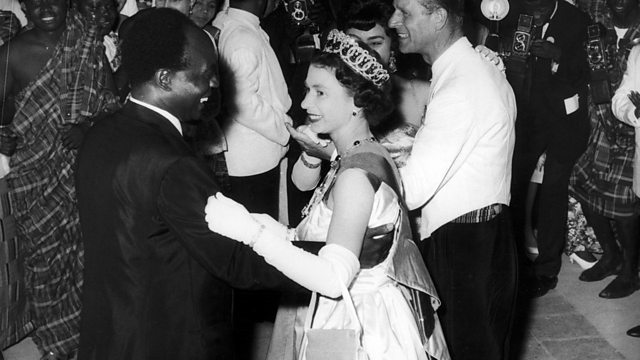
Queen Elizabeth II: A royal diplomat on Ghana's stage
On a visit to Ghana in 1961, with post-imperial change in the air, Elizabeth II recognised how she and President Nkrumah could work together to keep Ghana in the Commonwealth.
After 70 years on the throne, Queen Elizabeth II is the world’s most high profile global figure and a unique exemplar of diplomacy and soft power who, in her 70 years on the throne, has had an extraordinary influence at the centre of world affairs. She came to the throne in 1952 at a time of crisis and as the British Empire disintegrated in the aftermath of World War Two.
The Queen’s role as constitutional monarch and head of the Commonwealth placed her at the heart of global crises, and she visited Ghana, Zambia and South Africa as a diplomatic envoy, helping to mediate in the racial politics of post-colonial Africa. For Britain to retain status as a world power, it had to show it accepted the changes that were sweeping away its former Empire. In 1961, The Queen was in Ghana as an envoy of the British government which was trying to negotiate this new reality. She was also going as head of the Commonwealth of post-imperial nations - but with an uncertain future. Ghana's President Nkrumah was extremely direct in referencing the ‘winds of change’ but Elizabeth recognised how she and Nkrumah build a new relationship, inside the Commonwealth, at this crucial stage of Ghana's 'nation making'. Images of them dancing together at a state banquet played an important part in this.
Photo: Queen Elizabeth II of Great Britain dances with President Kwame Nkrumah of Ghana, 1961 Credit: Getty Images
Release date:
This clip is from.
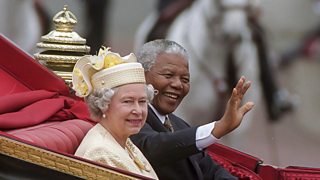
The Documentary — The Royal diplomat
More clips from the documentary.

The sounds of Europe's last primeval forest — Izabela in the forest
Duration: 03:04

What do you think you are?
Duration: 08:52
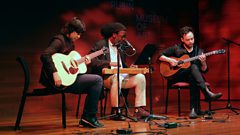
God Will Get The Glory Now
Duration: 02:31
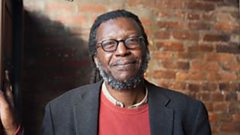
Duration: 07:22
Related Content
Similar programmes.
- Documentaries
- Online schedule
- Help & FAQs
- News in 39 languages
- Entertainment
What The Crown Gets Right About Queen Elizabeth II's History-Making Trip to Ghana
:upscale()/2017/12/17/025/n/1922283/883094b589563387_TheCrown_208_Unit_03066_R.jpg)
If there's one thing that Netflix's The Crown gets right (and occasionally wrong ), it's the details. The streaming giant's sprawling historical drama about the rise of Queen Elizabeth II (Claire Foy) is a stunning masterpiece that pulls directly from real-life events, footage, quotes, and letters to construct a compelling and realistic narrative about the life of the British royal family. Season two dives even deeper into iconic milestones from the monarch's impressive reign, including a 1961 dinner with President John F. Kennedy and First Lady Jackie Kennedy at Buckingham Palace , which is rumored to have had a hand in spurring on the queen's bold choice to visit Accra, the capital of Ghana.
After hearing rumors that the first lady considered her to be conservative and stuck in her ways, Queen Elizabeth reportedly decided to take action. Tensions were running high between Britain and Ghana, a commonwealth nation, so she decided to step in herself despite strong backlash from both her personal advisers and members of parliament. "I am not a film star," the queen said to then-Prime Minister Harold Macmillan . "I am the head of the Commonwealth — and I am paid to face any risks that may be involved. Nor do I say this lightly. Do not forget that I have three children."
Against the wishes of those around her due to bombing incidents in the country, Queen Elizabeth moved forward with her plans, which is portrayed in a later season two episode. Although not every single word that was shared between the queen and Ghana's Prime Minister Kwame Nkrumah can be known for sure, the broad strokes of her visit — which included a beautiful dance with the king at a party thrown in her honor — seem to line up with history. As far as clothing goes, The Crown 's costume designers also nailed it. Elizabeth wears an understated, pale yellow dress and matching hat when she touches down in Ghana and later dons a beautiful cream ball gown when she makes her momentous decision to dance with Nkrumah.
See the real-life photos side by side with Netflix's interpretation ahead!
:upscale()/2017/12/17/025/n/1922283/0f65c54933c4d371_TheCrown_208_Unit_00542_R.jpg)
Editor's note: an earlier version of this article referred to Kwame Nkrumah's title as King and has been updated.
- Queen Elizabeth II
- Social Responsibility

As the Head of the Commonwealth and the longest-serving British monarch, Queen Elizabeth, during her reign, was the most travelled. She travelled over 500 times, visiting 116 countries.
Two of those visits were to Ghana, which gained independence from the British just three years after her coronation. Although the visits were 38 years apart, the first in 1961 and the other in 1999, they were both significant and very memorable.
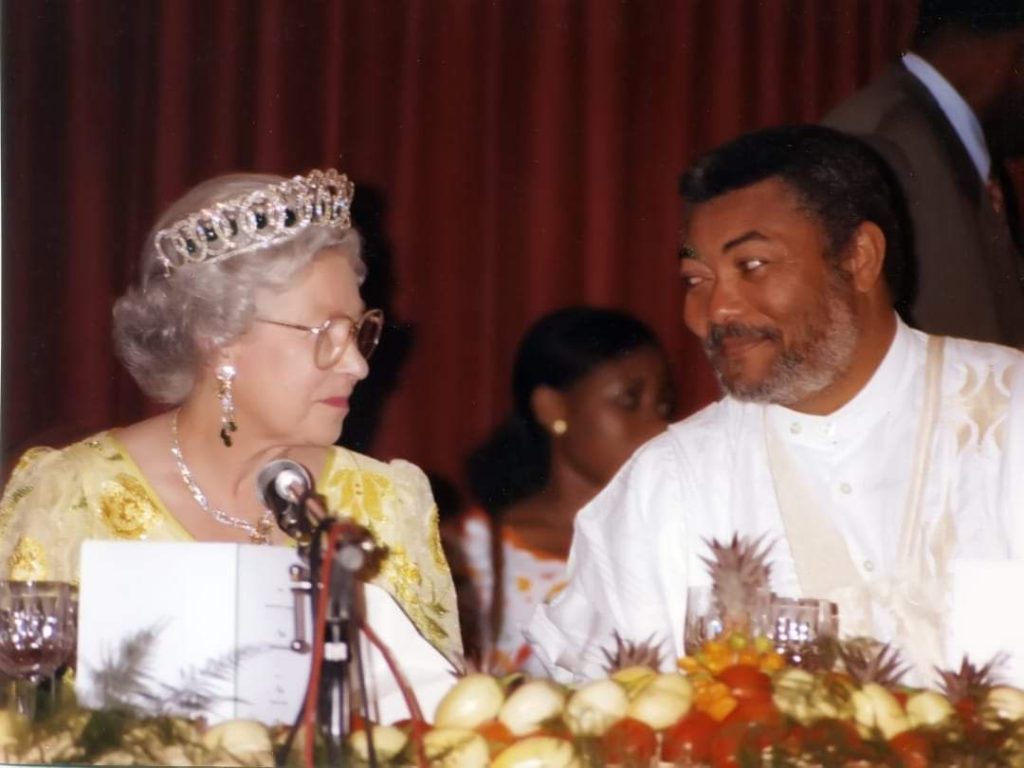
First Ghana visit – 1961
As head of the Commonwealth, and to show support for the fully-fledged Republic of Ghana, Queen Elizabeth II was scheduled to visit Ghana.
However, members of the UK Parliament were opposed to her travel, as they accused then President Dr. Kwame Nkrumah of turning into a dictator, after leading Ghana to independence in 1957.
They were wary of the visit becoming too dangerous, and as further evidence of the growing tensions, five days before Queen Elizabeth’s trip was to begin, bombs went off in the capital city, Accra.
Queen Elizabeth was adamant about travelling, despite the threat, insisting that she had always planned on making the trip to Ghana and the bombings did not alter that determination.
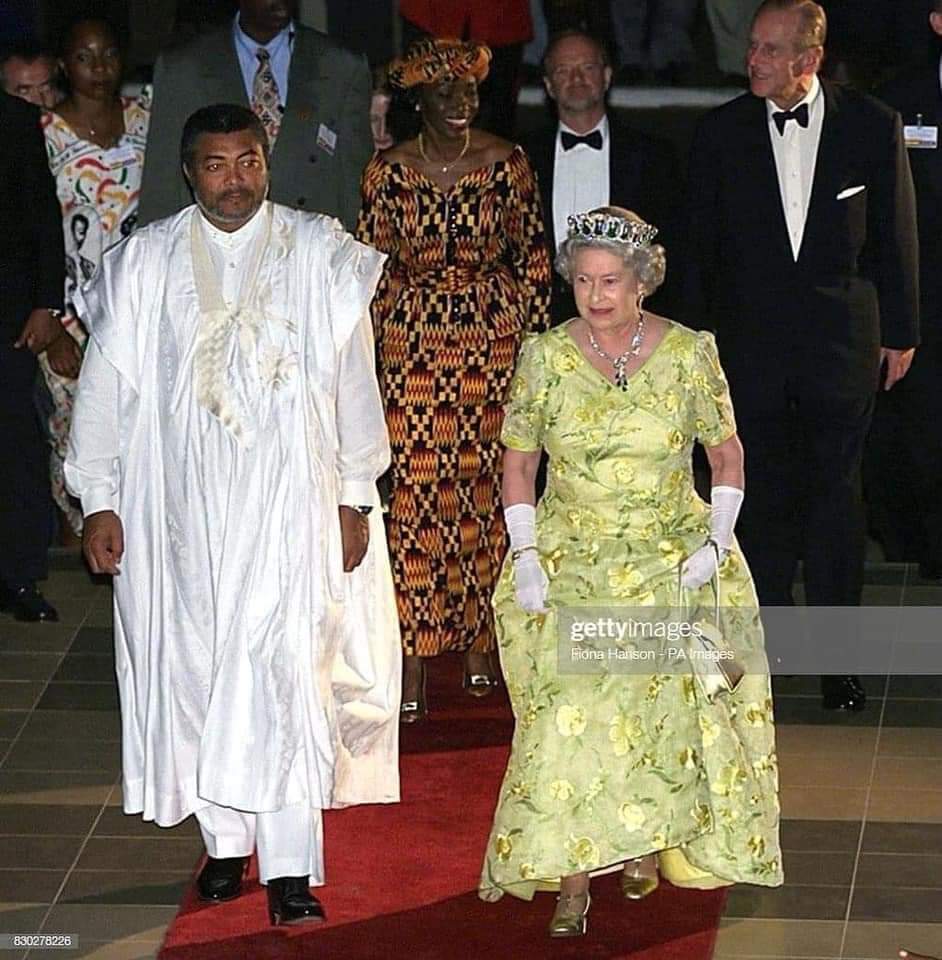
And though Ghana was part of the Commonwealth, along with other nations that had been part of the British Empire, she knew Nkrumah was getting restless.
As head of the Commonwealth, she was of the opinion that putting off a trip again to Ghana would be an embarrassment to Dr. Nkrumah, a situation that could influence the latter’s decision to leave the Commonwealth, as she was aware that he was getting closer to the Soviet Union, which wanted to expand its foothold in Africa amidst the Cold War.
“How silly I should look if I was scared to visit Ghana and then Soviet leader Nikita Khrushchev went and had a good reception,” she was quoted as saying in reaction to the concerns.
Thus, from November 9 to 20, 1961, Queen Elizabeth II embarked on her first official visit to Ghana, and, from the moment she arrived in Ghana, along with Prince Philip, she was surrounded by crowds and excitement.
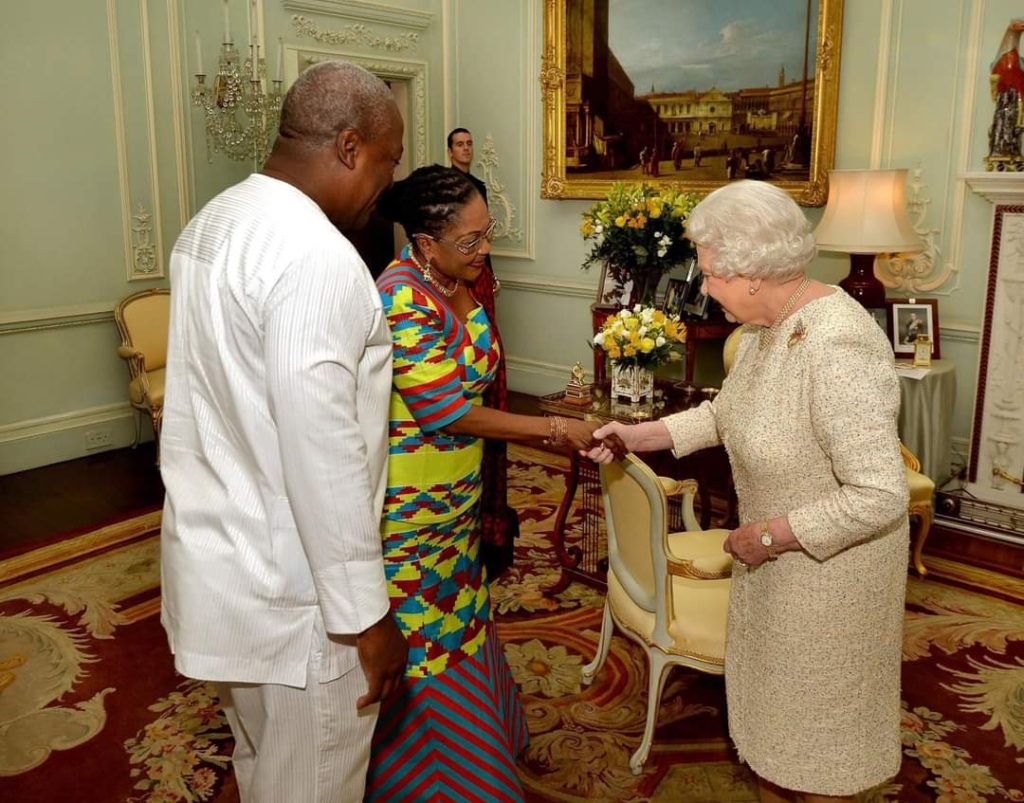
At a state dinner, Nkrumah toasted Queen Elizabeth by saying: “The wind of change blowing through Africa has become a hurricane. Whatever else is blown into the limbo of history, the personal regard and affection which we have for Your Majesty will remain unaffected.”
In responding to the toast, the Queen emphasised that it was alright for nations of the Commonwealth to disagree without members needing to leave.
Also, as part of the state dinner, Queen Elizabeth obliged Dr. Nkrumah to dance, and that caught the attention of the world, symbolic of the new relationship between a former master and a subject, now partners.
While in Ghana, Queen Elizabeth visited a young son of an imprisoned opposition leader, one that displeased Ghana’s President.
However, that did not take anything away from the overall impact of the Queen’s trip, which generated much goodwill and a lasting effect on the Commonwealth.
The Queen’s visit also helped Ghana get highly sought-after funding for the Volta Dam, a hydroelectric project that was the centerpiece of Nkrumah’s economic plans.
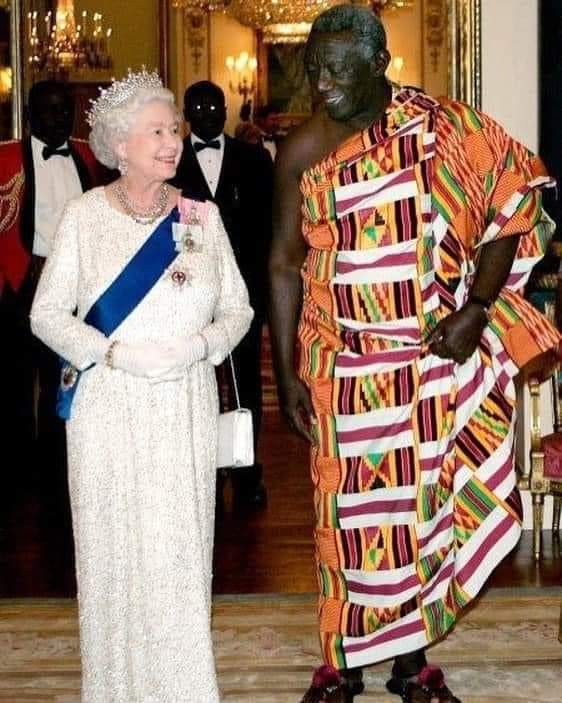
Determined to show Queen Elizabeth as much of Ghana as possible, her itinerary for the visit included an inspection parade at the Black Star Square and a visit to Kumasi, the Ashanti Regional capital, which she christened the Garden City of West Africa due to its flora.
While in Kumasi, the Queen and the Duke of Edinburgh also visited the Kumasi Sports Stadium (now Baba Yara Stadium) on November 16, 1961.
Also, she visited Tamale, where she and her entourage were treated to a dance performance on an outdoor parade ground.
Second visit – 1999
After 38 years, also in November, Queen Elizabeth and her husband visited Ghana for the second time.
If the first visit was a simple affair, the second was much more celebrated.
On November 7, 1999, she arrived, this time, with a bigger entourage and in more style, arriving in a chartered plane and accompanied by a 45-member delegation from the UK.
Descending from the plane, the Royal Couple were warmly welcomed by traditional dancers and drummers who sang her praises in the Ga language.
A 5,000 crowd also cheered and waved flags as then, President Jerry John Rawlings walked up the runway to welcome them. Right at the airport, the Queen and Prince Philip inspected a military guard of honour and was given a 21-gun salute on the tarmac.
While in Accra, the Queen called on her host, President Rawlings, at the Osu Castle, before going to deliver a speech in Parliament, where she profoundly praised Ghana for its achievements.
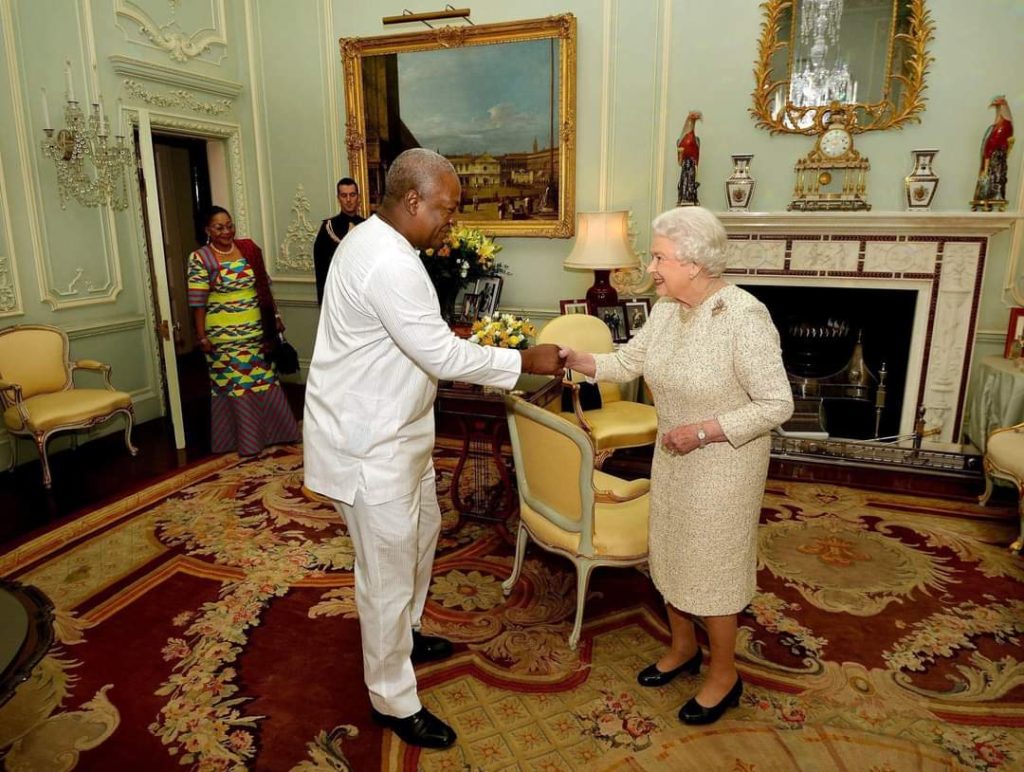
She also met with the then Vice President, Prof. John Evans Atta Mills, who would later become President. Addressing Parliament, Queen Elizabeth said her visit demonstrated the importance her country attached “to our relations with the people of Ghana”.
“I am, therefore, pleased that I have this chance to meet the elected members of Parliament representing all walks of life, all beliefs, and all shades of opinion in this diverse nation.
“It would be exactly 38 years ago tomorrow since I first came to Ghana. Much has changed since my last visit,” she said, intimating that while time might have passed between her visits and a lot of significant changes had occurred, she was impressed that Ghana’s celebrated reputation of hospitality remained the same.
“Prince Philip and I have been most touched by the warmth of the welcome we have been given here in Accra. We are delighted to be back,” she added.
She recalled that when she visited the country in 1961, Dr. Nkrumah had predicted that no matter how strong the wind of change in Africa might blow, the bonds of affection between Ghana and Britain would never be loosened.
Presidents’ visit to Queen Elizabeth
Although Queen Elizabeth did not return to Ghana on a visit, the cordial relationship between Buckingham Palace and Ghana remained, with some Ghanaian Presidents rather visiting her.
During his tenure, President John Agyekum Kufour visited Queen Elizabeth in London on March 13, 2007. The visit formed part of an official four-day state visit to Britain.
Former President John Dramani Mahama and his wife, Lordina Mahama, also visited Buckingham Palace for a meeting with the Queen in October 2014.
In April 2018, President Nana Addo Dankwa Akufo-Addo also visited the Queen.
Source: graphic.com.gh
- Queen Elizabeth II
‘Dahomey’ documentary on Europe’s looted African art wins Berlin film festival
Ghana: otumfuo receives first batch of looted royal artefacts from us museums, ghana: asanteman history book by otumfuo sir osei agyeman prempeh ii launched, most popular, recent comments, editor picks, cop28: un climate talks in jeopardy in fossil fuel backlash, former us first lady rosalynn carter dies aged 96, satellite images show scale of destruction in gaza, popular posts, peace corps to support over 2 million hours of volunteer and staff service in 50 countries – carol spahn, elijah addo : ghana chef serves free stew as more struggle to afford food, empowering marginalized girls: stage project shows the way, popular category.
- Lifestyle & entertainment 329
- World News 250
- Business 224
- Culture 219
- Education 136
- Social Responsibility 95
GAJ would provide platforms for cutting-edge discussions with key stakeholders on contemporary topics of interest to our audience.
Contact us: [email protected]/
© GAJ Report Developed by Teqconn
- Advertisement

IMAGES
COMMENTS
In 1961, Queen Elizabeth II planned to go to Ghana, a former British colony that had gained its independence in 1957. But before she left on the trip, which was to take place on November 9 to 20 ...
Shortly after her ascension to the throne, Queen Elizabeth was faced with a fast-changing empire as colonies in Africa gained independence and became republi...
Thursday, September 08, 2022 at 8:22 PM by George Nyavor. Queen Elizabeth visited Ghana twice before her demise on Thursday, September 8, 2022. She first visited Ghana in 1961 under Nkrumah's presidency and again in 1999 under Jerry John Rawlings. YEN.com.gh presents some of the rare photos that capture her visits to her former colony.
By the time of the queen's visit in 1961, the economy was crumbling, bribes were routinely collected by government officials at every level of the system (including by Nkrumah himself, who ...
Second visit - 1999. After 38 years, also in November, Queen Elizabeth and her husband visited Ghana for the second time. If the first visit was a simple affair, the second was much more celebrated.
In 1961, Queen Elizabeth visited several countries around the world, but perhaps what was most notable was her very first trip to Ghana, a country in West Africa. The young Queen showed during this trip that while the Royal's family's powers were limited the monarchy could still have an impact. Ghana is a former British colony that gained its ...
Queen Elizabeth II and President Nkrumah dance the popular Ghana rhythmic shuffle known as the "High Life" at a farewell ball in Accra on Saturday, November 18, 1961. AP. T he Queen danced gaily ...
The Queen decided to travel to Ghana from November 9 to 20, despite opposition from the British press and politicians, who were wary of a visit at a time when Kwame Nkrumah, then the Ghanaian ...
This visit witnessed parades and festivals in her honor with kings, queen-mothers, princes and a host of other nobles present to pay homage to the ruler of the commonwealth. The visit was preceded by lengthy deliberations regarding risks because of a bombing campaign in Ghana by opposition operatives.
Elizabeth II was Queen of Ghana from 1957 to 1960, when Ghana was an independent sovereign state and a constitutional monarchy. She was also queen of the United Kingdom and other sovereign states. ... In November 1959, Prince Philip paid a six-day visit to Ghana. During the visit, he inaugurated the Ghana Academy of Learning (now the Ghana ...
The Queen's visit to Ghana. The Queen insists on visiting Ghana in 1961, despite Prime Minister Harold Macmillan's fears for her safety. 26 March 2018. 2 minutes.
Bombing incidents in the capital Accra left officials worried about the safety of the Queen's visit to Ghana but, after deliberation, UK Prime Minister Harold Macmillan confirmed it would go ...
This first visit is contrasted with the Queen's second visit to Ghana in 1999. Dzifa talks to the former Minister of Education, Ekow Spio Garbrah who was present when the Queen gave an unusually ...
What the Netflix show gets right — and wrong — about Queen Elizabeth II's visit to Ghana in 1961. ... There's no dispute that the Ghana visit happened, or that Nkrumah and the queen shared a ...
On a visit to Ghana in 1961, with post-imperial change in the air, Elizabeth II recognised how she and President Nkrumah could work together to keep Ghana in the Commonwealth. ... Queen Elizabeth ...
While Queen Elizabeth II's visit was important in that it helped to cement cordial relations between Britain and Ghana and keep the latter in the (then British) Commonwealth, securing American co-financing of the Volta River Project shortly after the visit was of far greater importance in limiting Nkrumah's reliance on Soviet aid at the time.
Item title reads - Accra. Ghana acclaims Queen and Duke.Queen Elizabeth II and Prince Philip, Duke of Edinburgh, arrive in Accra, Ghana. L/S as the camera p...
As far as clothing goes, The Crown 's costume designers also nailed it. Elizabeth wears an understated, pale yellow dress and matching hat when she touches down in Ghana and later dons a beautiful ...
The Queen's visit also helped Ghana get highly sought-after funding for the Volta Dam, a hydroelectric project that was the centerpiece of Nkrumah's economic plans. Ghana tour. Determined to show Queen Elizabeth as much of Ghana as possible, her itinerary for the visit included an inspection parade at the Black Star Square and a visit to ...
Durbar in honour of Queen Elizabeth of England in Ghana with Dr Kwame Nkrumah, the First President of Ghana.
Category. v. t. e. Francis Kwame Nkrumah (21 September 1909 - 27 April 1972) was a Ghanaian politician, political theorist, and revolutionary. He served as Prime Minister of the Gold Coast from 1952 until 1957, when it gained independence from Britain. [1] He was then the first Prime Minister and then the President of Ghana, from 1957 until 1966.